Cisco Systems 88310756 CISCO VoIP Conference Phone User Manual
Cisco Systems Inc CISCO VoIP Conference Phone
Contents
- 1. Users Manual -Regulatory
- 2. Users Manual Revised 052813
Users Manual Revised 052813

Cisco Unified IP Phone 8831 User Guide for Cisco Unified
Communications Manager 9.3
First Published: April 15, 2013
Americas Headquarters
Cisco Systems, Inc.
170 West Tasman Drive
San Jose, CA 95134-1706
USA
http://www.cisco.com
Tel: 408 526-4000
800 553-NETS (6387)
Fax: 408 527-0883
THE SPECIFICATIONS AND INFORMATION REGARDING THE PRODUCTS IN THIS MANUAL ARE SUBJECT TO CHANGE WITHOUT NOTICE. ALL STATEMENTS,
INFORMATION, AND RECOMMENDATIONS IN THIS MANUAL ARE BELIEVED TO BE ACCURATE BUT ARE PRESENTED WITHOUT WARRANTY OF ANY KIND,
EXPRESS OR IMPLIED. USERS MUST TAKE FULL RESPONSIBILITY FOR THEIR APPLICATION OF ANY PRODUCTS.
THE SOFTWARE LICENSE AND LIMITED WARRANTY FOR THE ACCOMPANYING PRODUCT ARE SET FORTH IN THE INFORMATION PACKET THAT SHIPPED WITH
THE PRODUCT AND ARE INCORPORATED HEREIN BY THIS REFERENCE. IF YOU ARE UNABLE TO LOCATE THE SOFTWARE LICENSE OR LIMITED WARRANTY,
CONTACT YOUR CISCO REPRESENTATIVE FOR A COPY.
The following information is for FCC compliance of Class A devices: This equipment has been tested and found to comply with the limits for a Class A digital device, pursuant to part 15
of the FCC rules. These limits are designed to provide reasonable protection against harmful interference when the equipment is operated in a commercial environment. This equipment
generates, uses, and can radiate radio-frequency energy and, if not installed and used in accordance with the instruction manual, may cause harmful interference to radio communications.
Operation of this equipment in a residential area is likely to cause harmful interference, in which case users will be required to correct the interference at their own expense.
The following information is for FCC compliance of Class B devices: This equipment has been tested and found to comply with the limits for a Class B digital device, pursuant to part 15
of the FCC rules. These limits are designed to provide reasonable protection against harmful interference in a residential installation. This equipment generates, uses and can radiate radio
frequency energy and, if not installed and used in accordance with the instructions, may cause harmful interference to radio communications. However, there is no guarantee that interference
will not occur in a particular installation. If the equipment causes interference to radio or television reception, which can be determined by turning the equipment off and on, users are
encouraged to try to correct the interference by using one or more of the following measures:
•Reorient or relocate the receiving antenna.
•Increase the separation between the equipment and receiver.
•Connect the equipment into an outlet on a circuit different from that to which the receiver is connected.
•Consult the dealer or an experienced radio/TV technician for help.
Modifications to this product not authorized by Cisco could void the FCC approval and negate your authority to operate the product
The Cisco implementation of TCP header compression is an adaptation of a program developed by the University of California, Berkeley (UCB) as part of UCB’s public domain version
of the UNIX operating system. All rights reserved. Copyright ©1981, Regents of the University of California.
NOTWITHSTANDING ANY OTHER WARRANTY HEREIN, ALL DOCUMENT FILES AND SOFTWARE OF THESE SUPPLIERS ARE PROVIDED "AS IS" WITH ALL FAULTS.
CISCO AND THE ABOVE-NAMED SUPPLIERS DISCLAIM ALL WARRANTIES, EXPRESSED OR IMPLIED, INCLUDING, WITHOUT LIMITATION, THOSE OF
MERCHANTABILITY, FITNESS FOR A PARTICULAR PURPOSE AND NONINFRINGEMENT OR ARISING FROM A COURSE OF DEALING, USAGE, OR TRADE PRACTICE.
IN NO EVENT SHALL CISCO OR ITS SUPPLIERS BE LIABLE FOR ANY INDIRECT, SPECIAL, CONSEQUENTIAL, OR INCIDENTAL DAMAGES, INCLUDING, WITHOUT
LIMITATION, LOST PROFITS OR LOSS OR DAMAGE TO DATA ARISING OUT OF THE USE OR INABILITY TO USE THIS MANUAL, EVEN IF CISCO OR ITS SUPPLIERS
HAVE BEEN ADVISED OF THE POSSIBILITY OF SUCH DAMAGES.
Any Internet Protocol (IP) addresses used in this document are not intended to be actual addresses. Any examples, command display output, and figures included in the document are shown
for illustrative purposes only. Any use of actual IP addresses in illustrative content is unintentional and coincidental.
Cisco and the Cisco logo are trademarks or registered trademarks of Cisco and/or its affiliates in the U.S. and other countries. To view a list of Cisco trademarks, go to this URL: http://
www.cisco.com/go/trademarks. Third-party trademarks mentioned are the property of their respective owners. The use of the word partner does not imply a partnership
relationship between Cisco and any other company. (1110R)
©2013 Cisco Systems, Inc. All rights reserved.

CONTENTS
CHAPTER 1
Preface 1
Introduction 1
Additional Information 2
Safety and Performance Information 2
Power outage 2
External devices 2
Cisco product security overview 3
Accessibility Features 3
CHAPTER 2
Features of your Cisco Unified IP Phone 5
Buttons and hardware 5
Display Control Unit 6
Sound Base 7
Wireless extension microphone and charger 9
Wired extension microphone kit 11
Phone screen 12
Phone screen cleaning 14
Phone connections 14
Install ferrite bead 16
Remove ferrite bead 17
General IP Phone information 17
Power-saving mode 17
Feature availability 18
CHAPTER 3
Applications 19
Services 19
Access Services 19
Call History 19
Cisco Unified IP Phone 8831 User Guide for Cisco Unified Communications Manager 9.3
iii

View call history 20
View call record details 20
Dial from Call History 21
Edit phone number 21
Clear call history 21
Delete call record 22
Preferences 22
Ringtones 22
Change Ringtone 22
Contrast 23
Adjust Contrast 23
Linked Mode 23
Link IP Phones 24
IP Phone Information 24
Administrator Settings 25
CHAPTER 4
Contacts 27
Corporate Directory 27
Dial Contact from Search 27
Dial Contact from Search during an active call 28
Personal Directory 28
Personal Directory options 29
Sign In and Out of Personal Directory 29
Add Personal Directory entry 30
Search for entry in Personal Directory 30
Dial number from Personal Directory 31
Delete Personal Directory entry 31
Edit Personal Directory entry 31
Fast Dial codes with Personal Directory 32
Assign fast dial code to PAB from the phone 32
Assign fast dial code to PAB from User Options web page 32
Place call using fast dial code 33
Delete fast dial code 33
CHAPTER 5
Messages 35
Cisco Unified IP Phone 8831 User Guide for Cisco Unified Communications Manager 9.3
iv
Contents

Personalize voicemail 35
Voice message identification 35
Access voice messages 35
CHAPTER 6
Calling Features 37
Softkey feature map 38
Survivable Remote Site Telephony overview 39
Answer 41
Call Back 42
Set Up Call Back notification 42
Call Forward 42
Forward calls 43
Call Park 43
Park call 43
Call Pickup 44
Answer call using Pickup 44
Answer call using Group Pickup and Group Pickup Number 44
Answer call using Group Pickup and phone number 45
Answer call using Other Pickup 45
cBarge 45
Join conference on shared line 45
Conference 45
Add third party to conference 46
View conference participants 46
Remove conference participants 46
Divert 47
Divert call 47
Do Not Disturb 47
Turn DND on and off 47
Enhanced Room Coverage 48
Wireless Microphone menu 49
Pair wireless microphone 49
Unpair wireless microphone 50
Extension Mobility 51
Enable Extension Mobility 51
Cisco Unified IP Phone 8831 User Guide for Cisco Unified Communications Manager 9.3
v
Contents

Fast Dial 51
Place call using Fast Dial 52
Hold 52
Hold active call 52
Switch between active and multiple holding calls 53
Hold active call and answer new incoming call 53
Hold Reversion 53
Respond to Hold Reversion notification 53
Meet Me Conference 54
Host Meet Me Conference 54
Join Meet Me Conference 54
Mobile Connect 54
Enable Mobile Connect 55
Switch IP phone call to mobile phone 55
Switch mobile call to IP phone 56
Monitoring and Recording 56
Multiple calls per line 56
Multiple incoming calls 56
Call ended on line with multiple calls 56
Outbound call maximum 56
Answer second call on same line 57
Switch between calls on same line 57
Create conference with two calls on same line 57
Transfer two calls on same line 57
Shared Line 58
Mute 58
Mute IP phone sound base 59
Mute IP phone DCU 59
On-Hook dialing 59
Dial number on-hook 59
Plus Dialing 59
Dial international number 60
Privacy 60
Enable privacy on shared line 60
Quality Reporting Tool 61
Cisco Unified IP Phone 8831 User Guide for Cisco Unified Communications Manager 9.3
vi
Contents

Report IP phone problems 61
Redial 61
Redial number 61
Shared lines 61
Speed Dial 62
Place call using speed dial codes 62
Transfer 62
Transfer call to another number 62
WebDialer 63
Use WebDialer with Cisco directory 63
Use WebDialer with another online corporate directory 63
Change WebDialer preferences 64
CHAPTER 7
User Options web pages 65
Sign in and out of User Options web pages 65
Select device from User Options web page 66
Features and services setup on Web 66
Personal directory on Web 66
Personal Address Book on Web 66
Add new Personal Address Book entry 67
Search Personal Address Book entry 67
Edit Personal Address Book entry 67
Delete Personal Address Book entry 67
Fast Dials on Web 68
Assign Fast Dial code to Personal Directory entry 68
Assign Fast Dial code to phone number 68
Search for Fast Dial entry 69
Edit Fast Dial phone number 69
Delete Fast Dial Personal Address Book entry 69
Address book synchronization tool 69
Speed Dial setup on Web 70
Set up speed dial codes 70
Set up Abbreviated Dialing codes 70
Phone services setup on Web 71
Subscribe to service 71
Cisco Unified IP Phone 8831 User Guide for Cisco Unified Communications Manager 9.3
vii
Contents

Search for services 71
Change or end services 72
Change service name 72
Access service on phone 72
User settings on Web 72
Change browser password 73
Change PIN 73
Change user options web page language setting 73
Change phone display language 74
Line settings on Web 74
Set up Call Forward per line 74
Change voice message indicator setting per line 75
Change audible voice message indicator setting per line 75
Change ring type 75
Update line text label displayed on called party phone 76
Cisco WebDialer 76
Use WebDialer with User Options directory 76
Use WebDialer with another online corporate directory (not User Options
directory) 77
Log out of WebDialer 77
Set up, view, or change WebDialer preferences 77
CHAPTER 8
Additional options 79
CHAPTER 9
Troubleshooting 81
General troubleshooting 81
Phone administration data 82
Quality Reporting Tool 83
CHAPTER 10
Cisco one-year limited hardware warranty terms 85
View Cisco information packet 85
Cisco one-year limited hardware warranty terms 86
Cisco Unified IP Phone 8831 User Guide for Cisco Unified Communications Manager 9.3
viii
Contents

CHAPTER 1
Preface
Cisco Unified IP Phone 8831 User Guide describes how to install and use your Cisco Unified IP Phone
8831.
•Introduction, page 1
•Additional Information, page 2
•Safety and Performance Information, page 2
•Accessibility Features, page 3
Introduction
This guide provides you with an overview of the features available on your Cisco Unified IP Phone 8831.
You can read it completely for a solid understanding of the capabilities of your phone or refer to the table
below for pointers to commonly used sections.
Then...If you want to...
See Safety and Performance Information, on page
2.
Review safety information
See Phone connections, on page 14.Connect the phone
Start with Features of your Cisco Unified IP Phone,
on page 5.
Use the phone after it is installed
See Buttons and hardware, on page 5.Learn what the phone buttons mean
See Phone screen, on page 12.Learn about the display screen
See Calling Features, on page 37.Make calls
See Hold, on page 52.Put calls on hold
See Mute, on page 58.Mute calls
Cisco Unified IP Phone 8831 User Guide for Cisco Unified Communications Manager 9.3
1

Then...If you want to...
See Transfer, on page 62.Transfer calls
See Conference, on page 45.Make conference calls
See Speed Dial, on page 62.Set up speed dialing
See Shared lines, on page 61.Share a phone number
See Ringtones, on page 22.Change the ring volume or type
See Call History, on page 19.View your missed calls
See Messages, on page 35.Listen to your voice messages
Additional Information
You can access the most current Cisco documentation at this URL:
http://www.cisco.com/ipphones/8800
You can access the Cisco website at this URL:
http://www.cisco.com/
You can access the most current licensing information at this URL:
http://www.cisco.com/en/US/docs/voice_ip_comm/cuipph/all_models/openssl_license/8800_ssllic.html
Safety and Performance Information
The following sections provide information about the impact of power outages and external devices on your
Cisco Unified IP Phone.
Power outage
Your access to emergency service through the phone depends on the phone being powered. If there is a power
interruption, Service and Emergency Calling Service dialing will not function until power is restored. In case
of a power failure or disruption, you may need to reset or reconfigure the equipment before using the Service
or Emergency Calling Service dialing.
External devices
Cisco recommends using good quality external devices such as headsets, cables, and connectors that are
shielded against unwanted radio frequency (RF) and audio frequency (AF) signals.
Cisco Unified IP Phone 8831 User Guide for Cisco Unified Communications Manager 9.3
2
Preface
Additional Information
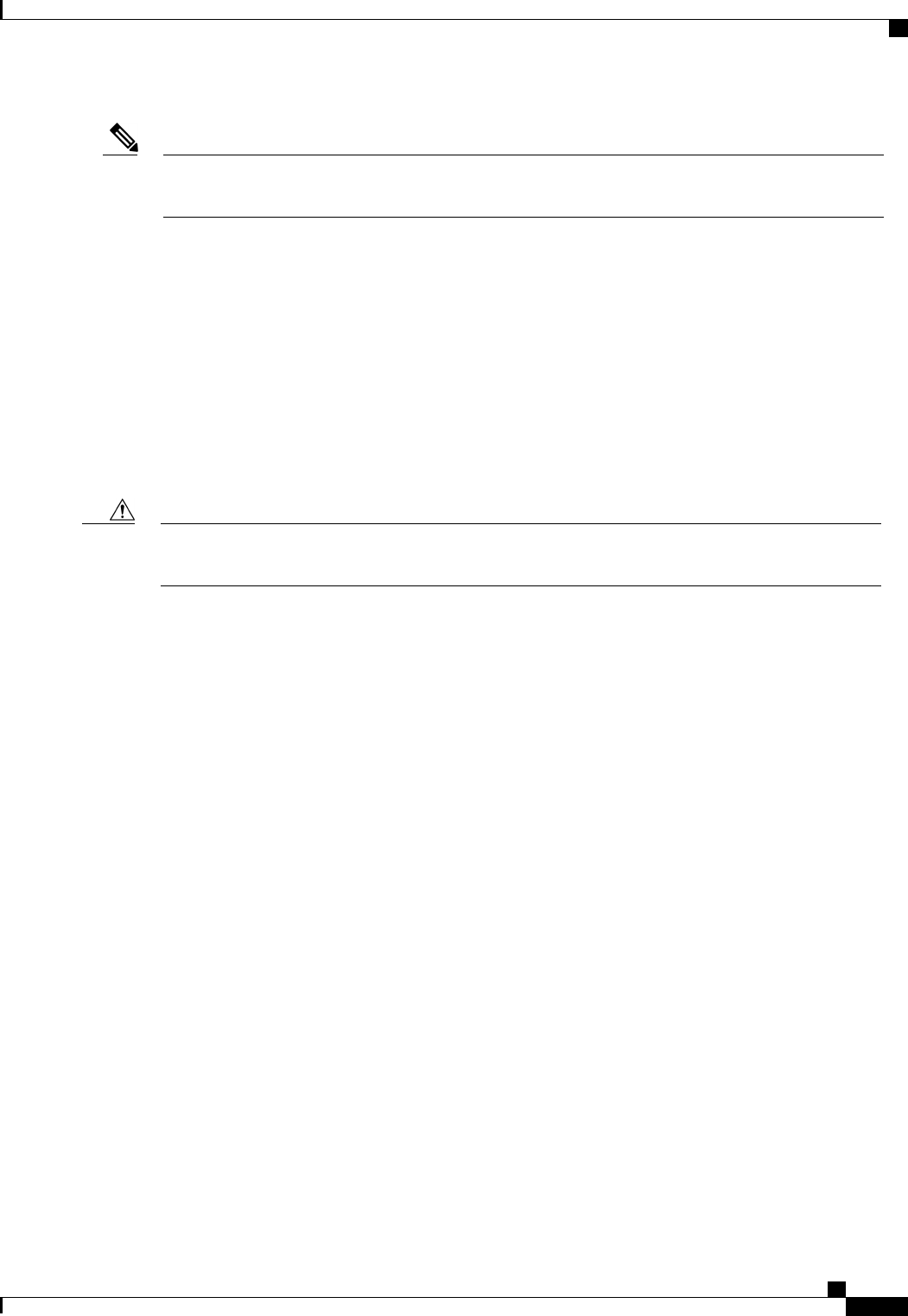
Not all Cisco IP Telephony products support external devices, cords or cables. For more information,
consult the documentation for your phone.
Note
Depending on the quality of these devices and their proximity to other devices such as mobile phones or
two-way radios, some audio noise may still occur. In these cases, Cisco recommends that you take one or
more of these actions:
•Move the external device away from the source of the RF or AF signals.
•Route the external device cables away from the source of the RF or AF signals.
•Use shielded cables for the external device, or use cables with a better shield and connector.
•Shorten the length of the external device cable.
•Apply ferrites or other such devices on the cables for the external device.
Cisco cannot guarantee the performance of external devices, cables, and connectors.
In European Union countries, use only external speakers, microphones, and headsets that are fully compliant
with the EMC Directive [89/336/EC].
Caution
Cisco product security overview
This product contains cryptographic features and is subject to United States and local country laws governing
import, export, transfer, and use. Delivery of Cisco cryptographic products does not imply third-party authority
to import, export, distribute, or use encryption. Importers, exporters, distributors, and users are responsible
for compliance with U.S. and local country laws. By using this product you agree to comply with applicable
laws and regulations. If you are unable to comply with U.S. and local laws, return this product immediately.
Further information regarding U.S. export regulations may be found at http://www.access.gpo.gov/bis/ear/
ear_data.html.
Accessibility Features
The Cisco Unified IP Phone 8800 Series provides accessibility features for the vision impaired, the blind, and
the hearing and mobility impaired.
For detailed information about the features on these phones, see http://www.cisco.com/en/US/docs/
voice_ip_comm/cuipph/all_models/accessibility/english/user/guide/access_70.html.
You can also find more information about accessibility at this Cisco website:
http://www.cisco.com/web/about/responsibility/accessibility/index.html
Cisco Unified IP Phone 8831 User Guide for Cisco Unified Communications Manager 9.3
3
Preface
Cisco product security overview

Cisco Unified IP Phone 8831 User Guide for Cisco Unified Communications Manager 9.3
4
Preface
Accessibility Features

CHAPTER 2
Features of your Cisco Unified IP Phone
The Cisco Unified IP Phone 8831 is a full-featured single line conference station that provides voice
communication over an IP network. It functions much like a digital business phone, allowing you to place
and receive calls and to access features such as mute, hold, transfer, speed dial, call forward, and more. In
addition, because conference stations connect to your data network, they offer enhanced IP telephony features,
including access to network information and services, and customizable features and services.
The conference station provides a backlit LCD screen, support for up to ten speed-dial numbers, and a variety
of other sophisticated functions. Optional microphone extension kits provide enhanced room coverage that
can be further expanded by linking two units together.
In addition to basic call-handling features, your conference station can provide enhanced productivity features
that extend your call-handling capabilities. Depending on configuration, the conference station supports:
•Access to network data, XML applications, and web-based services.
•Online customizing of conference station features and services from your User Options web pages.
•Buttons and hardware, page 5
•Phone screen, page 12
•Phone connections, page 14
•General IP Phone information, page 17
•Feature availability, page 18
Buttons and hardware
The Conference Station has two primary components:
•Display Control Unit (DCU)
•Sound Base
In addition, the following optional extension kits can be added to or used with the conference station:
•Wired Microphone Extension Kit
•Wireless Microphone Extension Kit and Charger
Cisco Unified IP Phone 8831 User Guide for Cisco Unified Communications Manager 9.3
5
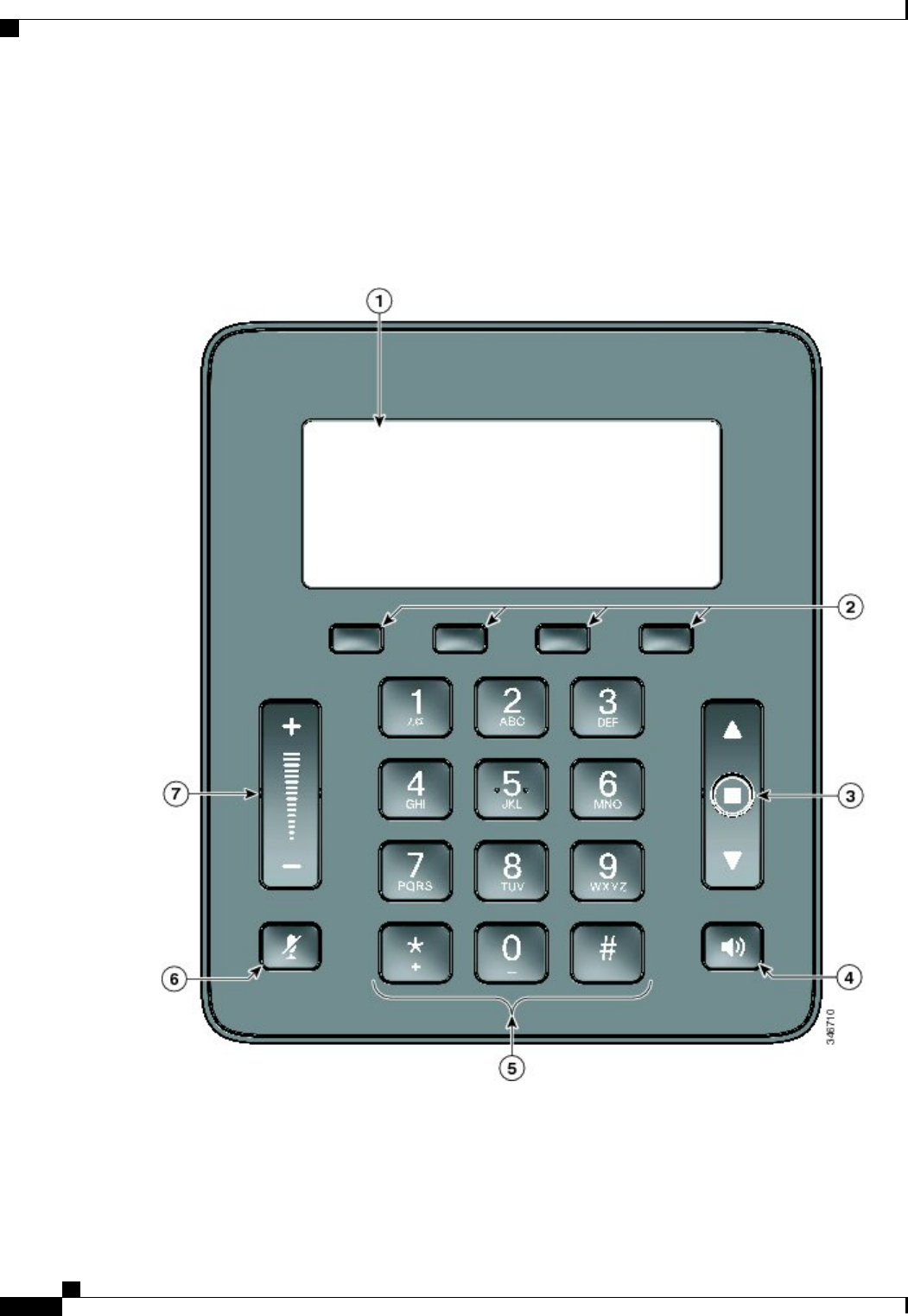
For your conference station to work, it must be connected to the corporate IP telephony network.
Display Control Unit
The Display Control Unit (DCU) is tethered to the Sound Base via a micro USB connector.
You can use the graphic and table below to identify buttons and hardware on the DCU.
Cisco Unified IP Phone 8831 User Guide for Cisco Unified Communications Manager 9.3
6
Features of your Cisco Unified IP Phone
Display Control Unit
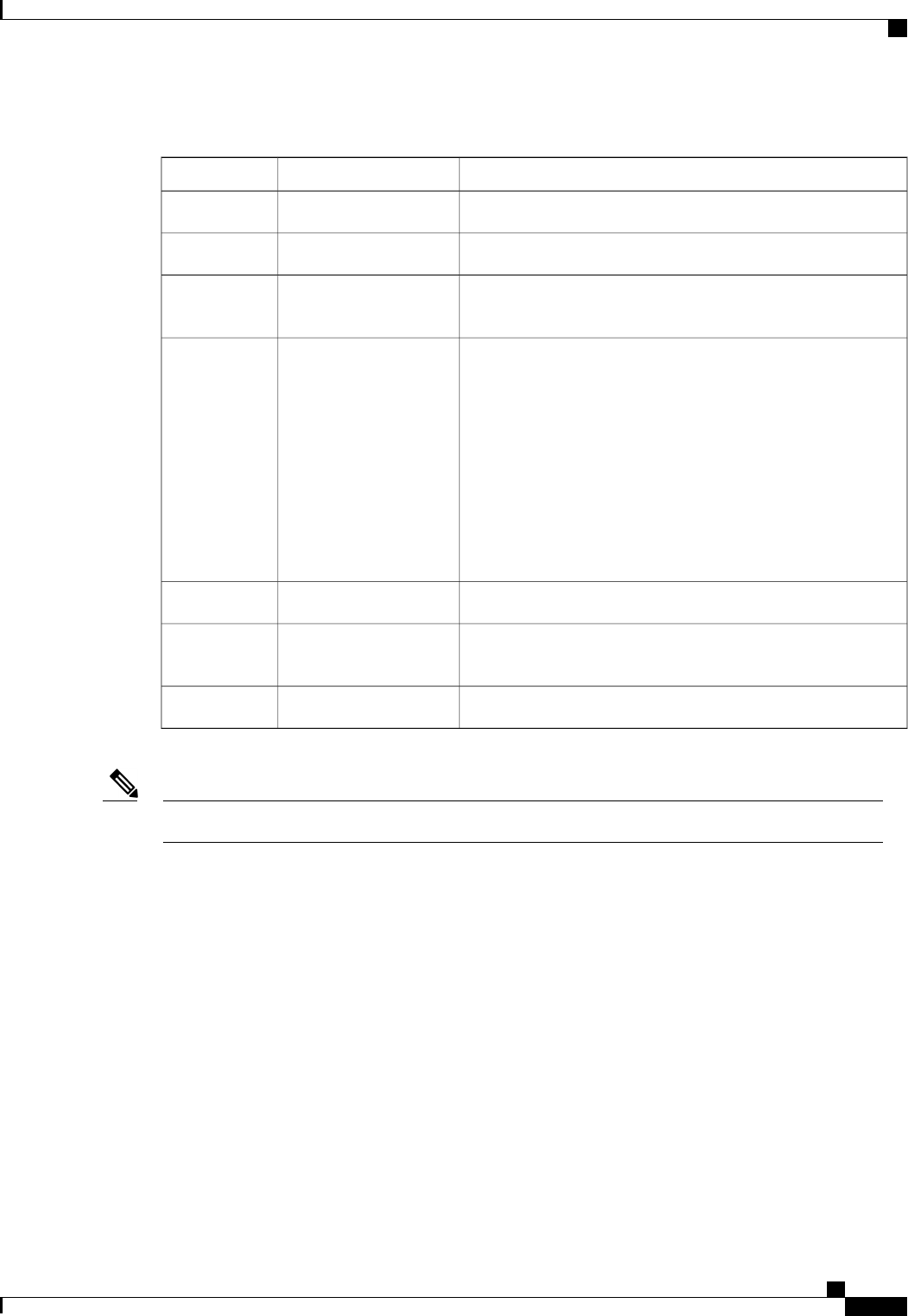
Table 1: Display Control Unit buttons and softkeys
DescriptionItem
LCD screen that displays conference station menus and features.Phone screen1
Four programmable keys.Softkeys2
2-way navigation bar and Select key that allows you scroll menus
and select items on the display.
Navigator with Select
key
3
LED backlit call button.
Press this key to:
•Go Off Hook
•Answer an incoming call
•Obtain a dial tone to initiate a call
•Resume a call
•Release a call
Call button4
Allows you to dial phone numbers and enter letters.Keypad5
Toggles the Mute feature. A red back light indicates a call is on
mute.
Mute button6
2-way rocker switch that raises the volume of the speaker.Volume rocker7
For details on DCU LED behavior, see LED state definitions.Note
Sound Base
The Sound Base provides 360 degree audio coverage via four built-in microphones and supports a full duplex
speaker phone.
To provide enhanced room coverage, two sound base units can be linked together.
You can use the graphic and table below to identify buttons and connections on the Sound Base.
Cisco Unified IP Phone 8831 User Guide for Cisco Unified Communications Manager 9.3
7
Features of your Cisco Unified IP Phone
Sound Base
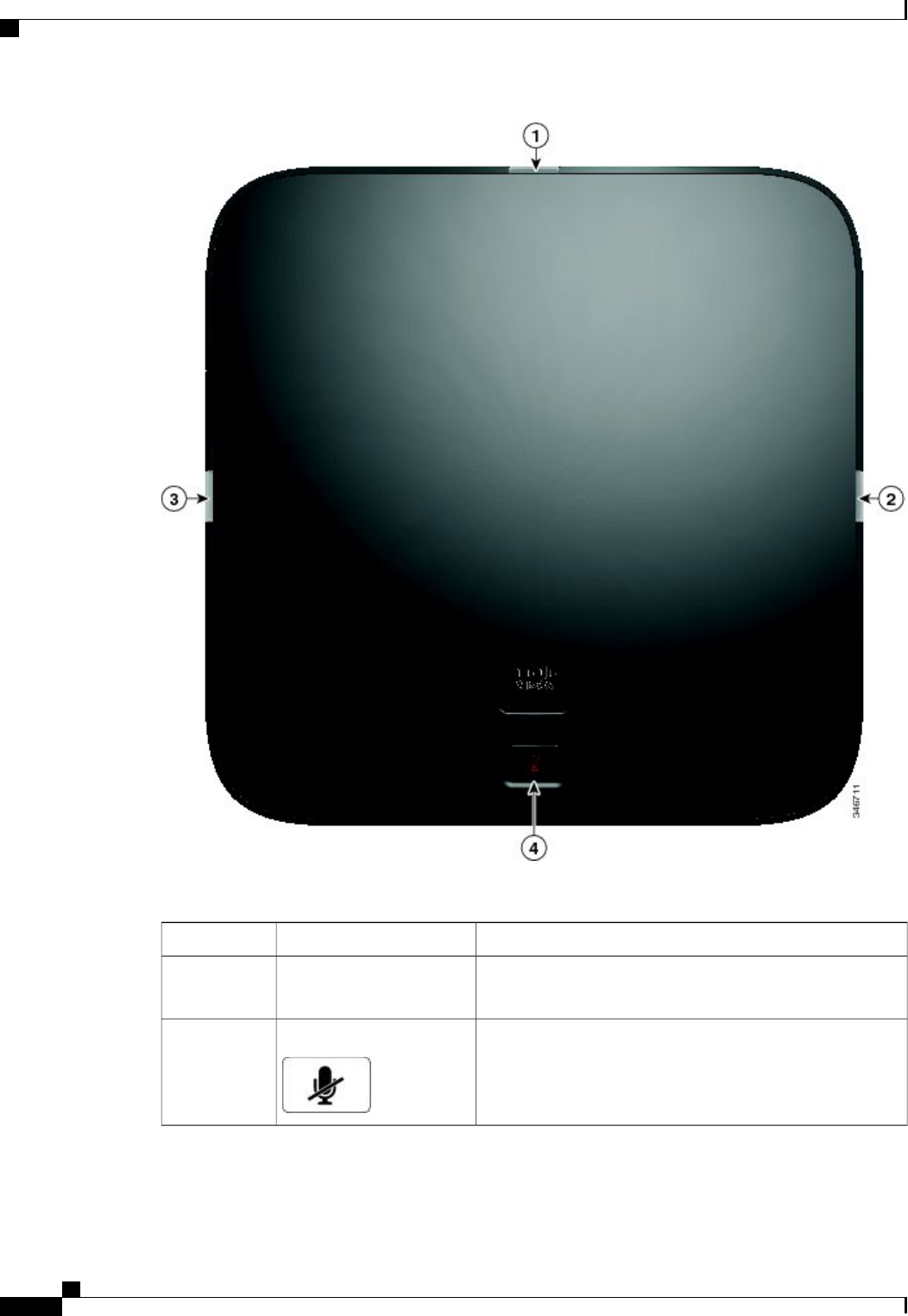
Table 2: Sound Base buttons
DescriptionItem
Three LED indicators provide call status information. For
details on LED behaviour, see LED state definitions.
LED indicators1, 2, 3
Backlit mute button.Mute button4
Cisco Unified IP Phone 8831 User Guide for Cisco Unified Communications Manager 9.3
8
Features of your Cisco Unified IP Phone
Sound Base
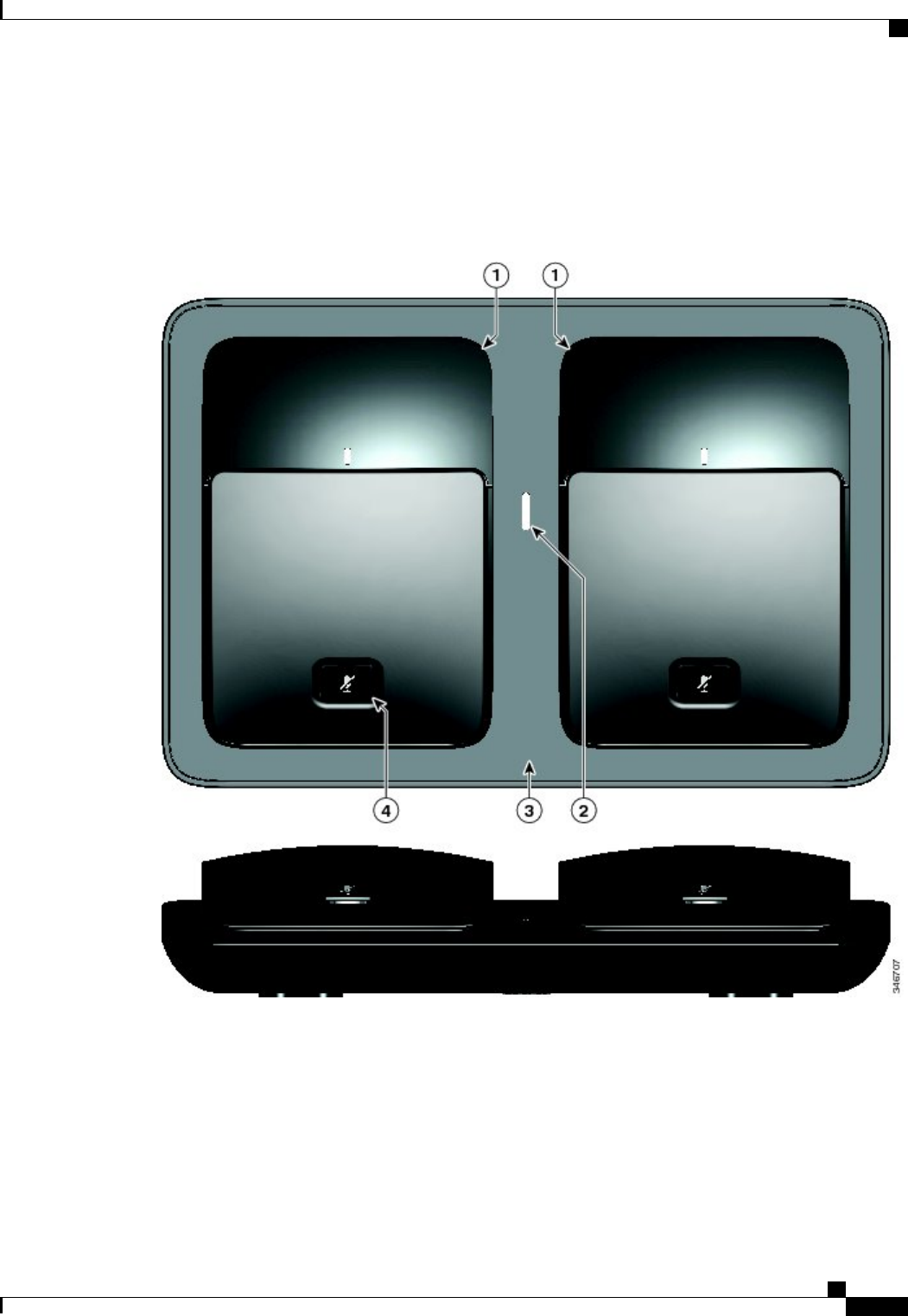
Wireless extension microphone and charger
The optional wireless extension microphone and charger kit unit contains two omni-directional wireless
microphones, a charger unit and two country specific AC power clip adaptors for powering the charger unit.
Connecting a microphone kit enhances the room coverage of the conference station.
Cisco Unified IP Phone 8831 User Guide for Cisco Unified Communications Manager 9.3
9
Features of your Cisco Unified IP Phone
Wireless extension microphone and charger
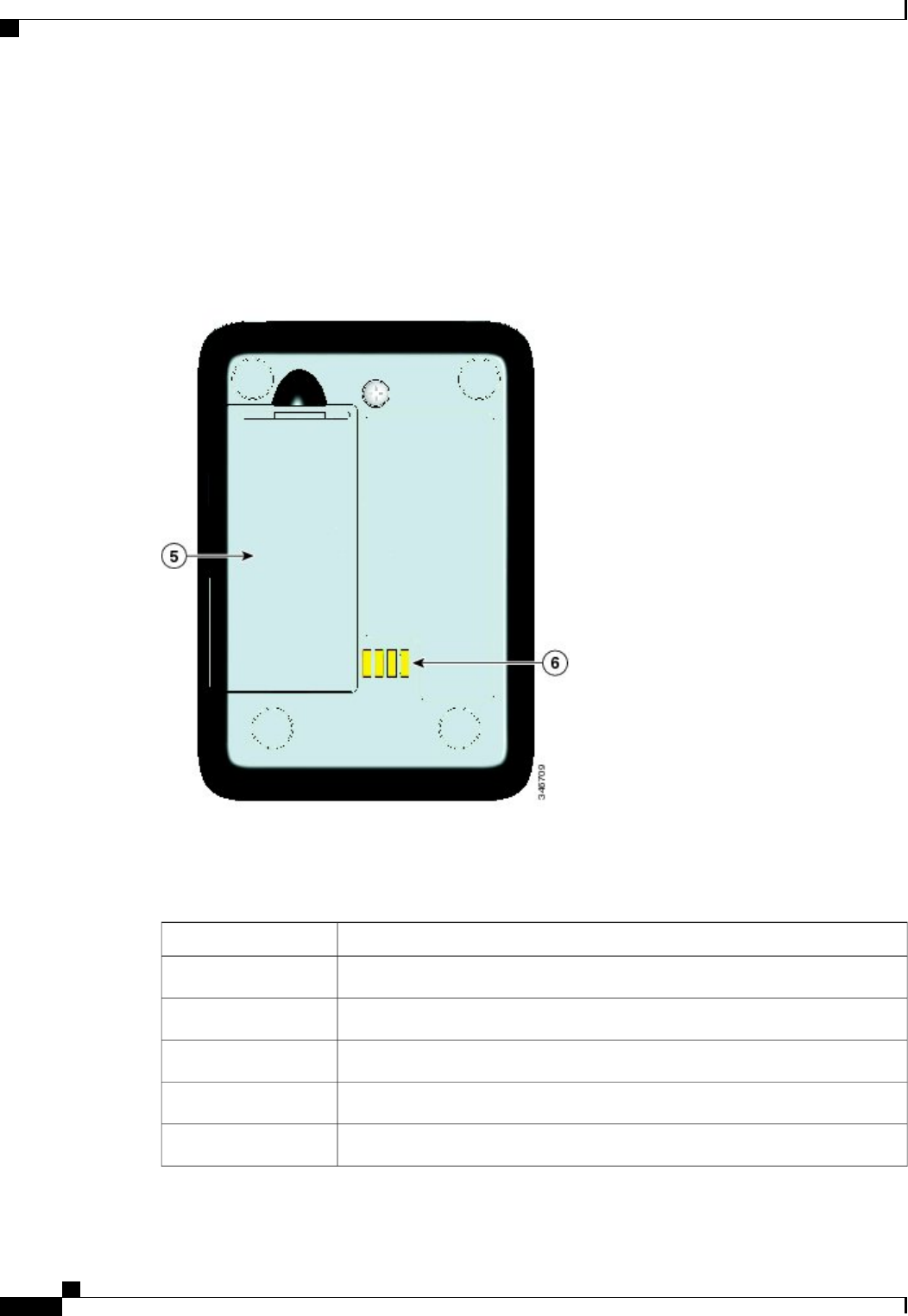
Table 3: Wireless microphone and charger buttons and features
DescriptionItem
Omni-directional wireless microphones1
LED charge status indicator2
Charger tray3
Mute button4
Battery compartment5
Cisco Unified IP Phone 8831 User Guide for Cisco Unified Communications Manager 9.3
10
Features of your Cisco Unified IP Phone
Wireless extension microphone and charger
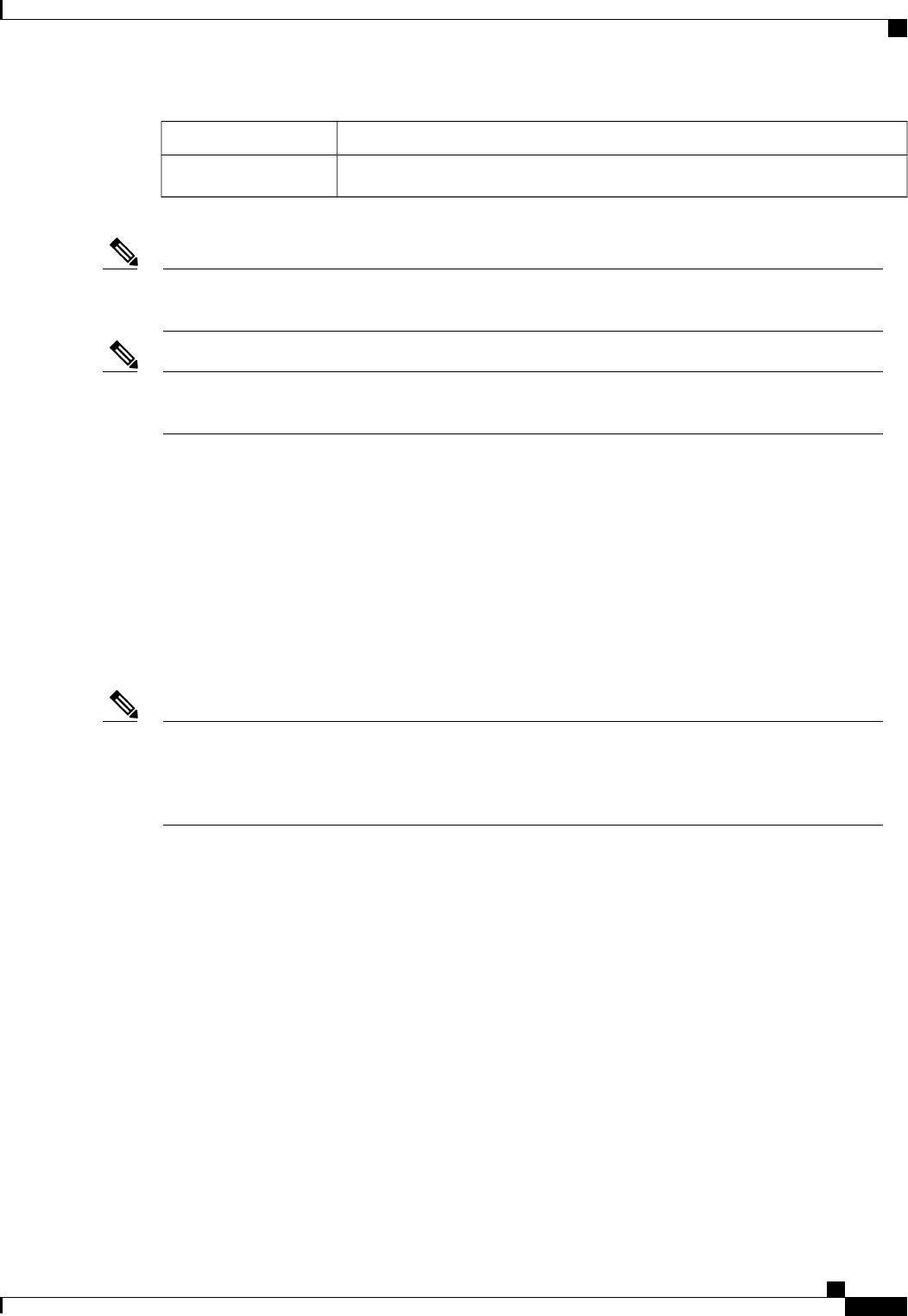
DescriptionItem
Power level indicator.6
Please see the FCC ID approval number under the Battery Cover for CP-MIC-WRLS-S-US= Wireless
Microphone. FCC ID: LDKMICWR0776
Note
Please see the Canada IC approval number under the Battery Cover for the CP-MIC-WRLS-S-US=
Wireless Microphone. IC: 2461B-MICWR0776
Note
Wired extension microphone kit
The optional wired expansion microphone kit includes two wired omni-directional microphones. Connecting
a microphone kit enhances the room coverage of the conference station. The sound base has two wired
microphone ports and you can connect one or both wired microphones.
If the conference station is connected to another sound base in Linked Mode, the primary base station supports
one or two wireless microphones, or it supports one wired microphone. The secondary unit supports only one
wired microphone; a wireless microphone cannot be connected to a secondary Sound Base. You cannot mix
microphone kits: if you plan to connect a microphone to both sound bases, they must both be wired microphones.
Wired and wireless microphones cannot be used at the same time, and the wireless microphones have a
higher priority. Attempting to connect a wired microphone to a conference station that has paired or
connected channels results in a warning to the user that the wired microphone is disabled. To solve this
problem, unpair any paired or connected wireless microphones before connecting a wired microphone.
Note
Cisco Unified IP Phone 8831 User Guide for Cisco Unified Communications Manager 9.3
11
Features of your Cisco Unified IP Phone
Wired extension microphone kit
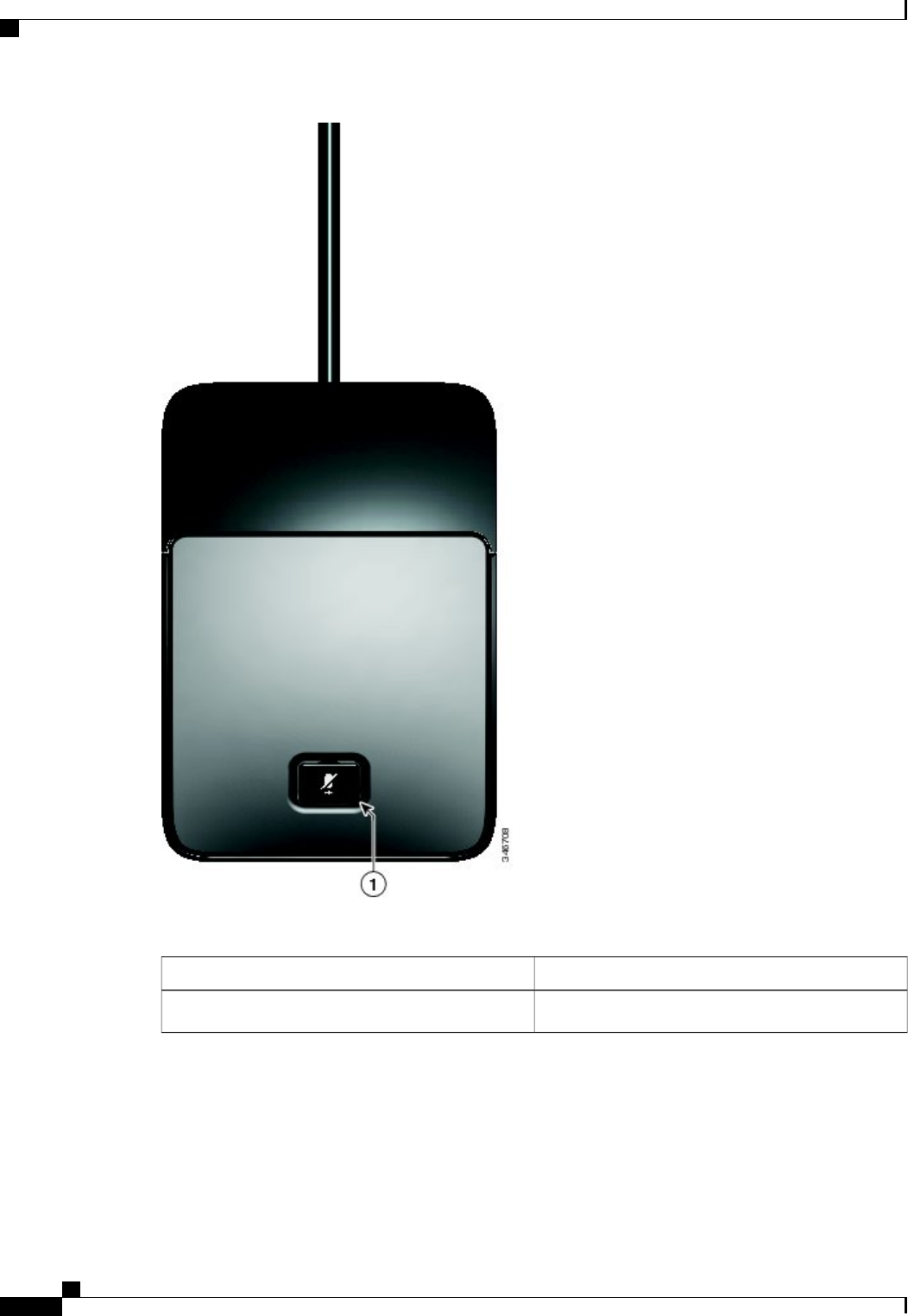
Table 4: Wired microphone buttons
DescriptionItem
Mute button.1
Phone screen
The LCD screen of the phone is located on the DCU. The idle or home screen displays information about the
status of calls and features.
Cisco Unified IP Phone 8831 User Guide for Cisco Unified Communications Manager 9.3
12
Features of your Cisco Unified IP Phone
Phone screen
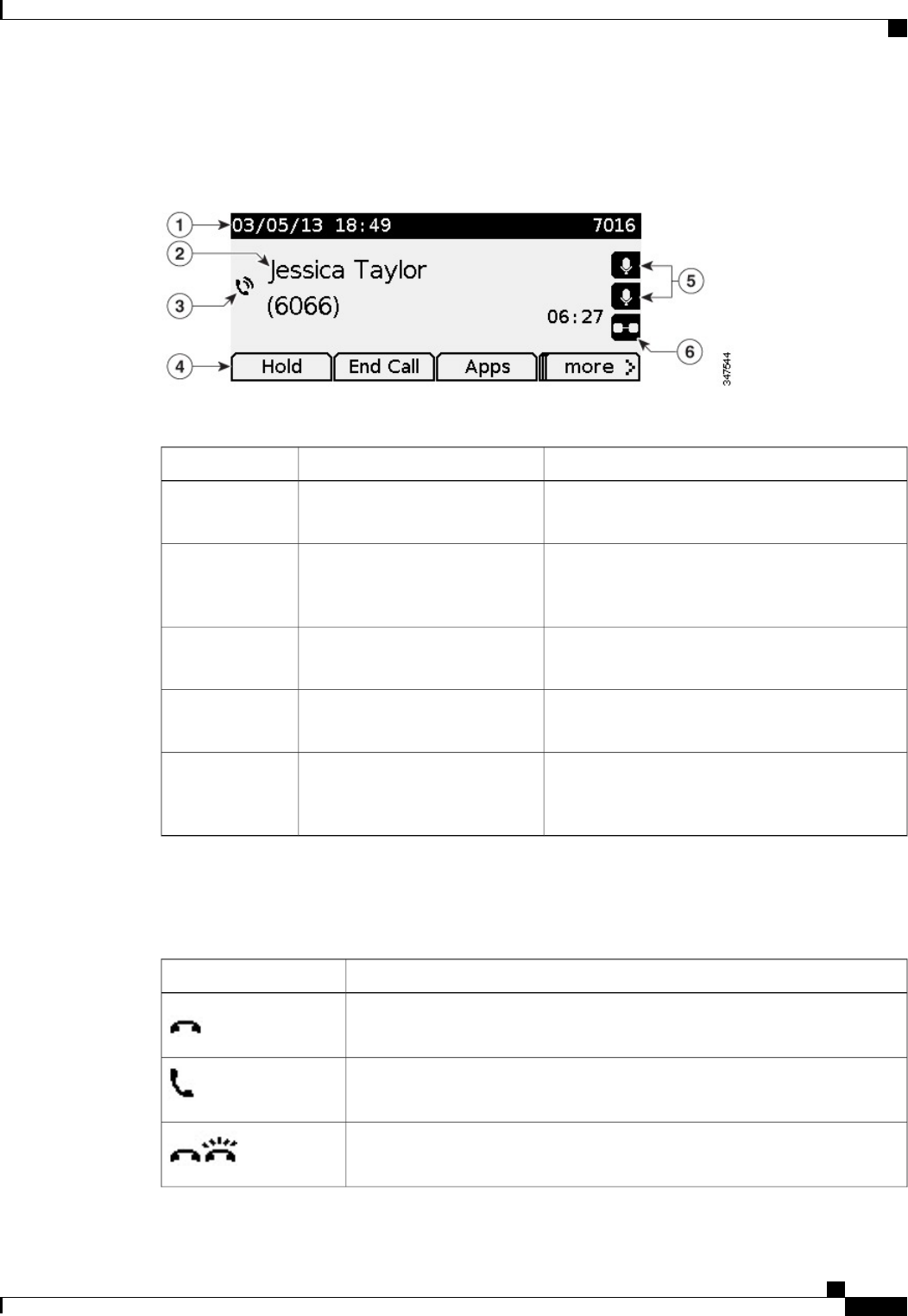
If the conference station is in an offline state, the idle screen displays the message Phone is not
registered and the Apps softkey remains available.
You can use the graphic and table below to identify the features and functions available on the screen.
Table 5: Phone screen layout.
DescriptionItem
Displays date, time, and current directory number.
Displays menu name when applicable.
Header1
Displays line label, call details, and status messages
such as missed calls, message waiting, and line
forwarding information.
Line details and other phone
information
2
Indicates the status of a call, such as ringing, hold,
encrypted or connected call.
Call State icon3
Displays softkeys for currently available features or
actions.
Softkey labels4
These icons are displayed when an associated
feature, such as extension microphones (5) or Link
mode (6) is connected.
Feature icons5, 6
Phone screen icons
Table 6: Phone screen icons
DescriptionIcon
On hook
Off hook
Ringing in
Cisco Unified IP Phone 8831 User Guide for Cisco Unified Communications Manager 9.3
13
Features of your Cisco Unified IP Phone
Phone screen
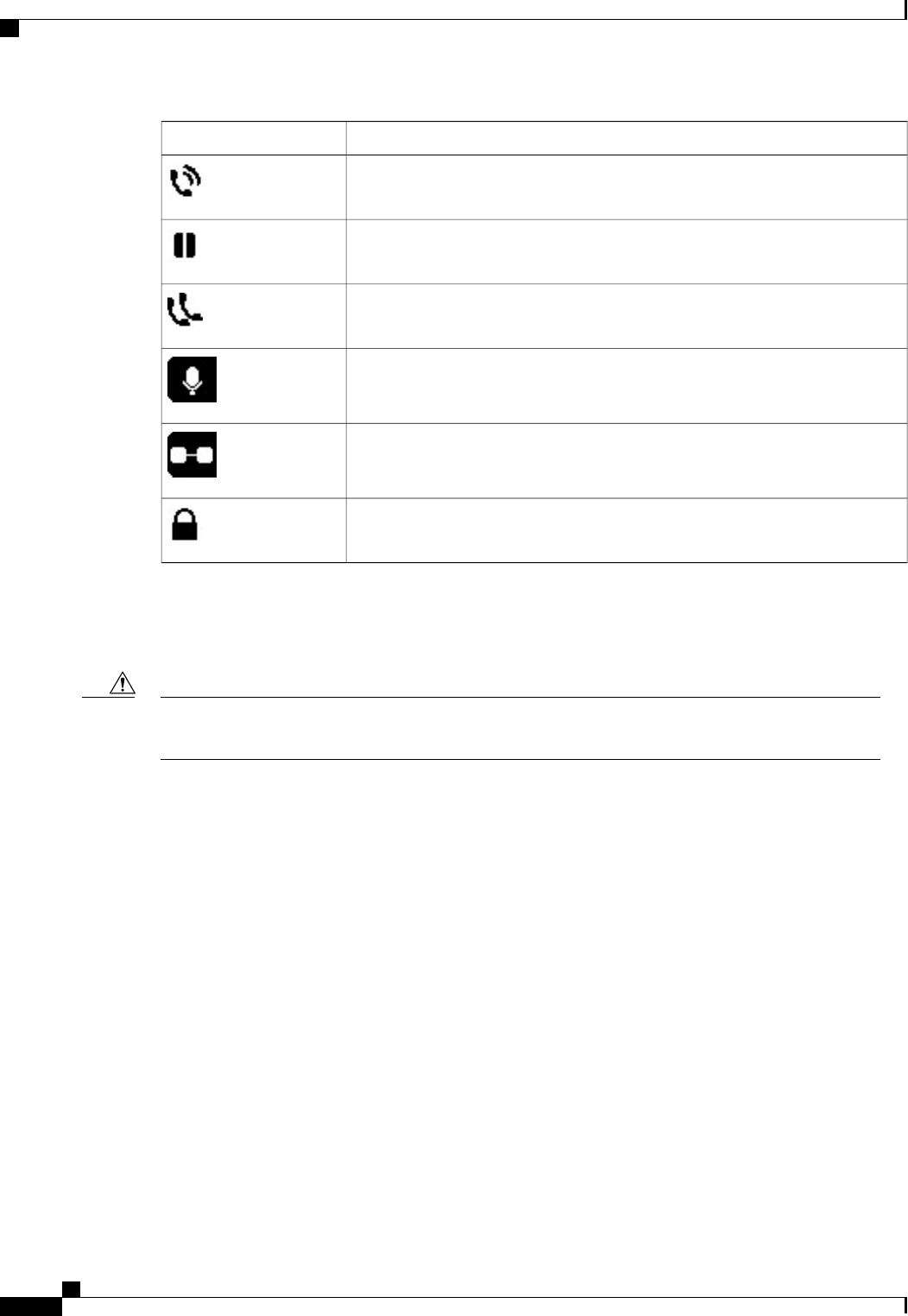
DescriptionIcon
Connected
Hold
Shared line
Microphone connected
Linked mode
Encrypted
Phone screen cleaning
Use only a soft, dry cloth to wipe your conference station display screen. Do not use any liquids or powders
on the phone, as they can contaminate phone components and cause failures.
Caution
Phone connections
Network and power are connected to the phone from the Sound Base. The mini-USB connection for the DCU,
the wired microphone ports and the daisy chain port for the Linked Mode feature are also located on the base.
You can use the graphic and table below to identify connections and ports on the Sound Base.
Cisco Unified IP Phone 8831 User Guide for Cisco Unified Communications Manager 9.3
14
Features of your Cisco Unified IP Phone
Phone screen cleaning
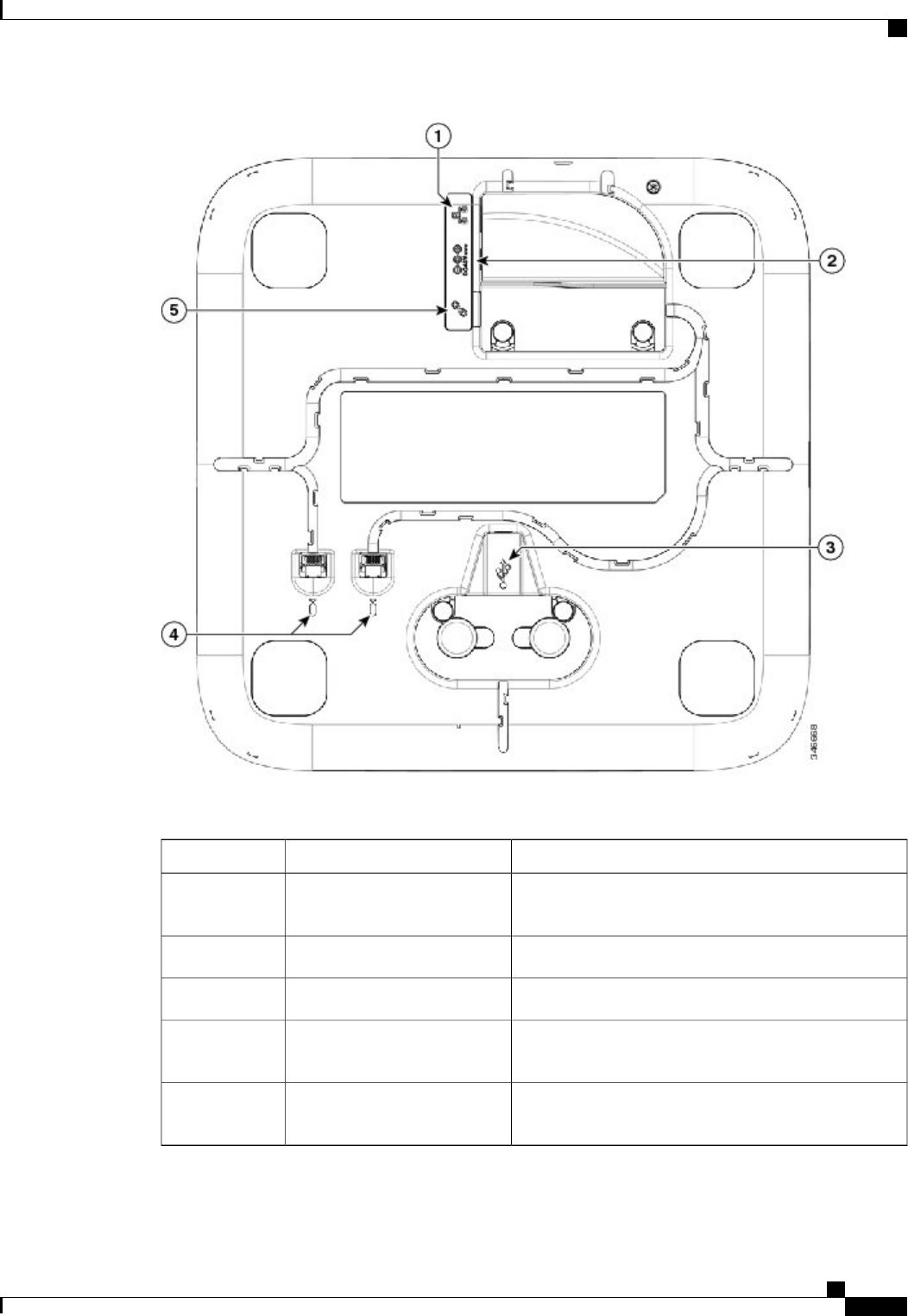
Table 7: Sound Base connections and ports
DescriptionItem
Network port (10/100 SW) connection. IEEE 802.3af
power enabled.
Network port1
Local power connection.Wall power2
Connects the base station to the DCU.Mini USB port3
Two RJ11 microphone ports. An optional wired
microphone can be connected to each port.
Wired microphone ports4
Supports the connection of two base stations in Linked
Mode.
Linked Mode daisy chain port5
Cisco Unified IP Phone 8831 User Guide for Cisco Unified Communications Manager 9.3
15
Features of your Cisco Unified IP Phone
Phone connections
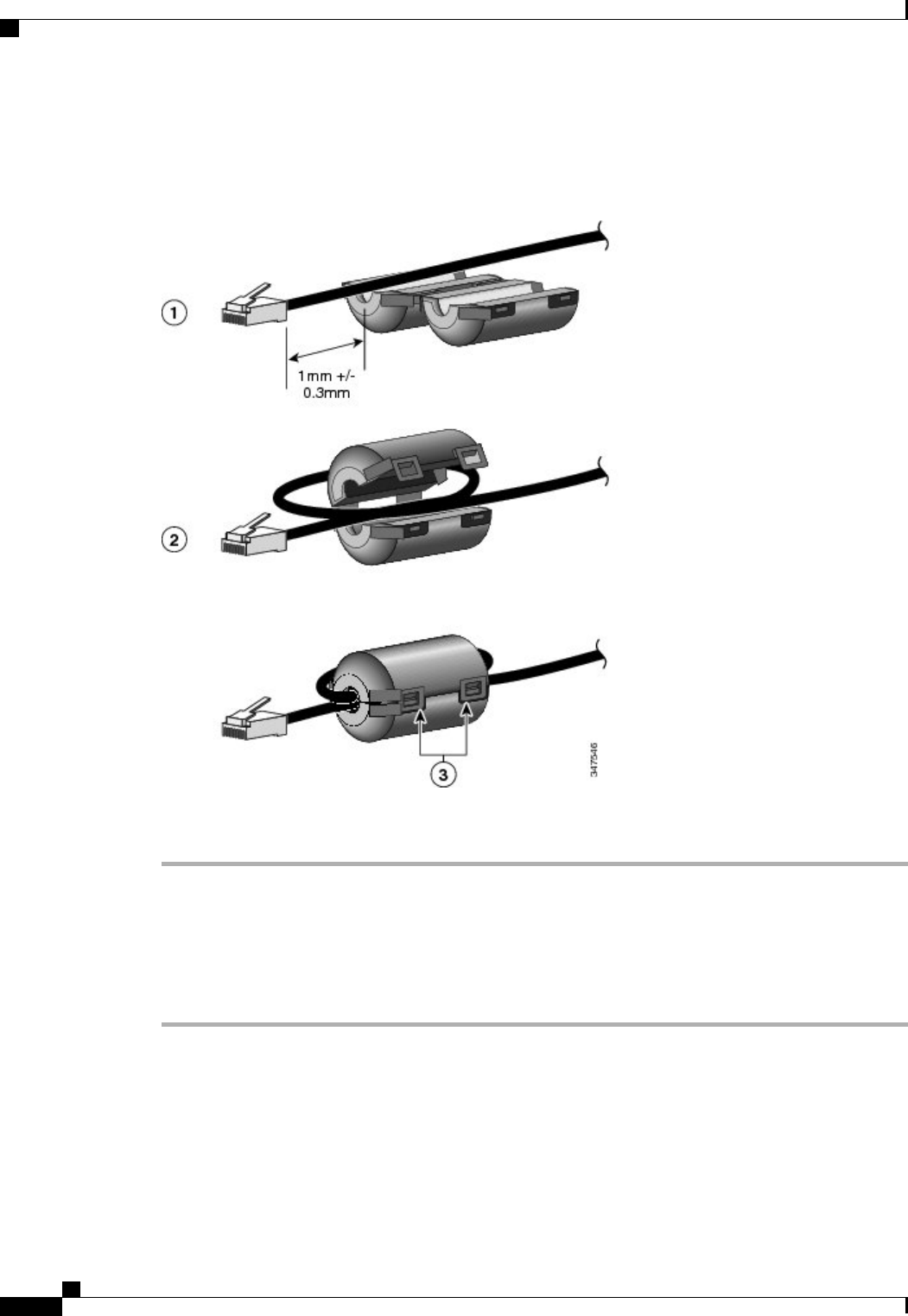
Install ferrite bead
The following images show how to install the ferrite bead on the network cable.
Procedure
Step 1 Align the ferrite bead with the head of the network cable and move the ferrite bead along the cable until there
is a gap of 1.0 mm +/- 0.3 mm between the bead and the connector.
Step 2 Place the cable into the ferrite bead channel and loop the cable around the ferrite bead so that the cable exits
the bottom of the bead.
Step 3 Hold the cable in the ferrite bead channel and close the ferrite bead. Both snaps on the ferrite bead should
engage.
Cisco Unified IP Phone 8831 User Guide for Cisco Unified Communications Manager 9.3
16
Features of your Cisco Unified IP Phone
Install ferrite bead
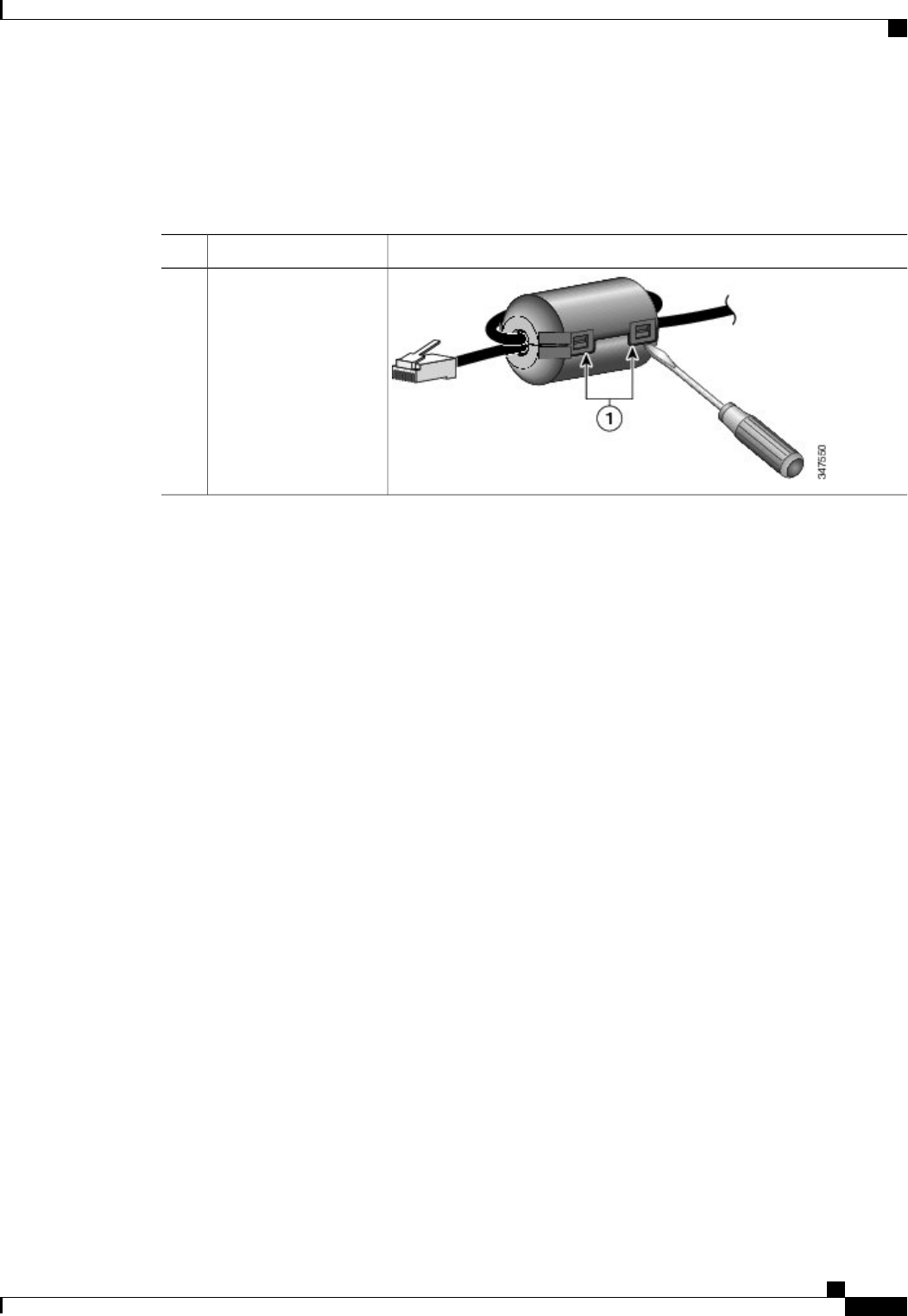
Remove ferrite bead
Procedure
PurposeCommand or Action
Disengage the snap
enclosure with a small
screwdriver as shown in
the figure.
Step 1
General IP Phone information
Power-saving mode
Your conference station supports the Cisco EnergyWise (EW) program. Your system administrator sets up
sleep (power down) and wake (power up) times for your conference station to save energy. In the sleep state,
the LED for the sound base Mute button becomes solid gray, and the DCU powers off.
Ten minutes before the scheduled sleep time, you receive a message that the conference station will power
down at a specific time. If the power-saving mode is enabled by your system administrator, you hear your
ringtone play. The ringtone plays according to the following schedule:
•At 10 minutes before power down, the ringtone plays four times
•At 7 minutes before power down, the ringtone plays four times
•At 4 minutes before power down, the ringtone plays four times
•At 30 seconds before power down, the ringtone plays 15 times or until the phone powers down
If your conference station is inactive (idle) at the sleep time, it powers down. If your conference station is
active (for example, on a call), it waits until it has been inactive for a period of time before removing power.
After the conference station goes to sleep, press the Mute button on the sound base to wake the conference
station up. You cannot wake the conference station using the DCU. After it is inactive for a period of time,
the conference station goes back to sleep. At the set wake time, the conference station powers up.
Wake and sleep times are also linked to the configured days that you normally work. If your requirements
change (for example, your work hours or work days change), contact your system administrator to have your
conference station reconfigured.
For more information about EnergyWise and your conference station, contact your system administrator.
Cisco Unified IP Phone 8831 User Guide for Cisco Unified Communications Manager 9.3
17
Features of your Cisco Unified IP Phone
General IP Phone information

Feature availability
Depending on the conference station system configuration, features included in this guide might not be
available to you or might work differently on the conference station. Contact your support desk or system
administrator for information about feature operation or availability.
Cisco Unified IP Phone 8831 User Guide for Cisco Unified Communications Manager 9.3
18
Features of your Cisco Unified IP Phone
Feature availability

CHAPTER 3
Applications
•Services, page 19
•Call History, page 19
•Preferences, page 22
•Linked Mode, page 23
•IP Phone Information, page 24
•Administrator Settings, page 25
Services
Conference Station services can include special telephony features, network data, and web-based information.
The services available for your phone depend on the system configuration and the services you are subscribed
to. For more information, see your system administrator.
Access Services
Procedure
Step 1 Press Apps.
Step 2 Use the navigation bar and Select button to scroll and select the service you want to access.
Step 3 Press the Select softkey, or press Exit to return to the Applications screen.
Call History
Call History allows you to view information about calls made to and from the conference station. A call state
icon is displayed to indicate the type of call:
Cisco Unified IP Phone 8831 User Guide for Cisco Unified Communications Manager 9.3
19

•Received
•Placed
•Missed
A maximum of 50 records are stored for each history type.
The caller ID is displayed with the call icon. If the caller ID is unavailable, then the phone number is displayed.
If the phone number is unavailable, then the message Unknown is displayed. All Call History items are
integrated into one list and are ordered by time (latest to oldest).
You can dial a number directly from the Call History list.
If set up by your administrator, the received and placed calls from shared lines are logged in the Call History.
To view all the call history logs, open the Call History screen.
View call history
Procedure
Step 1 Press Apps.
Step 2 Use the navigation bar and Select button to scroll and select Call History.
View call record details
Procedure
Step 1 Press Apps.
Step 2 Use the navigation bar and Select button to scroll and select Call History.
Step 3 Select a call record and press Details.
If the Details softkey is not visible on the screen, press More first.
Step 4 Press to return to the Call History list.
Cisco Unified IP Phone 8831 User Guide for Cisco Unified Communications Manager 9.3
20
Applications
View call history

Dial from Call History
Procedure
Step 1 Press Apps.
Step 2 Use the 2-way navigation bar and Select button to scroll and select Call History.
Step 3 From the Call History list, select the call you want to dial and press Call.
Edit phone number
Procedure
Step 1 Press Apps.
Step 2 Use the navigation bar and Select button to scroll and select Call History.
Step 3 Select the call you want to edit.
Step 4 Press Edit Dial
Step 5 Press >> to move the cursor to the right and press << to move the cursor to the left.
•Pressing the Up arrow of the 2-way rocker sends the cursor to ahead of the left-most character.
•Pressing the Down arrow of the 2-way rocker sends the cursor to ahead of the right-most character.
Step 6 Press to delete numbers.
Step 7 Press Dial to dial the edited number.
Step 8 Press to return to the Call History list.
Clear call history
Procedure
Step 1 Press Apps.
Step 2 Use the navigation bar and Select button to scroll and select Call History.
Step 3 Press Clear.
Step 4 Press Delete to delete the Call History list, or press Cancel to go back to the Call History screen.
Cisco Unified IP Phone 8831 User Guide for Cisco Unified Communications Manager 9.3
21
Applications
Dial from Call History

Delete call record
Procedure
Step 1 Press Apps.
Step 2 Use the navigation bar and Select button to scroll and select Call History.
Step 3 Select the call you want to delete.
Step 4 Press Del Call.
Step 5 Press Delete to delete the call, or press Cancel to go back to the Call History screen.
Preferences
Ringtones
You can customize how the conference station indicates an incoming call and a new voice mail message. You
can also adjust the ringer volume. In addition to the default ringtone, you can customize your phone to have
up to six distinctive ring tones. Ring tone preferences can be set directly on your phone, or from your User
Options web page.
Related Topics
User Options web pages, on page 65
Change Ringtone
Procedure
Step 1 Press Apps.
Step 2 Use the navigation bar and Select button to scroll and select Preferences.
Step 3 Select Ringtone.
Step 4 Select a ringtone.
Step 5 Press Play to play a sample.
Step 6 Press Set to select the ringtone.
Step 7 PressApply to confirm your selection, or press Cancel to go back to the Ringtone screen.
Step 8 Press to return to the Preferences screen.
Cisco Unified IP Phone 8831 User Guide for Cisco Unified Communications Manager 9.3
22
Applications
Delete call record

Contrast
You can adjust the contrast level of the LCD screen. The default contrast level is 50%.
Adjust Contrast
Procedure
Step 1 Press Apps.
Step 2 Use the navigation bar and Select button to scroll and select Preferences.
Step 3 Select Contrast.
Step 4 To increase contrast, press the up arrow on the navigation bar. To decrease contrast, press the down arrow.
Step 5 Press Save to set the contrast level, or press Cancel to exit.
Linked Mode
Two conference station Sound Base units can be linked together to expand the audio coverage area. One
Sound Base acts as the primary device, and the other unit acts as the dependant or secondary device.
In Linked Mode, the primary base station supports either one wireless or one wired microphone. The secondary
unit supports only one wired microphone. You cannot mix microphone kits: if you plan to connect a microphone
to both sound bases, they must both be wired microphones.
When linked, voice, dial tone, ringer and base LED features are synchronized between the two devices. You
can link two sound bases while a call is active.
When Linked Mode is active, the linked mode icon is shown in the idle and the call screens.
The following table summarizes the best practice to follow when deploying your conference stations in Linked
Mode. If the devices are linked in this manner, the system software automatically detects which device is to
be used as the primary and which is the secondary one.
Table 8: Linked Mode setup best practice
Connect to SecondaryConnect to PrimaryComponent
NoYesDisplay Control Unit (DCU)
NoYesNetwork cable
NoYesWall power
YesYesOptional Wired Microphone
NoYesOptional Wireless Microphone
Cisco Unified IP Phone 8831 User Guide for Cisco Unified Communications Manager 9.3
23
Applications
Contrast

If a DCU is connected to the secondary device, it will display a prompt indicating that it is a dummy DCU,
but will otherwise not function.
Note
When using a Sound Base in Linked Mode, the primary base unit must be connected using the
CP-PWR-CUBE-3 external power supply.
Caution
If two devices are linked after both are registered, the user can select which is the primary device.
A secondary device receives upgrades to firmware seamlessly from the primary device.
Link IP Phones
Linked Mode is set up by using a daisy cable to connect two Cisco Unified IP Phone 8831 Sound Base units.
This procedure describes the best practice for connecting the two units.
Procedure
Step 1 Connect the DCU to the conference station to be used as the primary unit.
Step 2 Connect the network cable to the conference station to be used as the primary unit.
Step 3 Connect the power cable to the primary device and plug into a wall plug .
The secondary Sound Base does not need to be plugged into external power, but in Linked Mode the primary
unit must be connected to external power.
Step 4 Use the provided daisy cable to connect the primary unit to the secondary sound base.
Voice, dial tone, ringer and base LEDs are synchronized between the two units.
Related Topics
Linked Mode, on page 23
IP Phone Information
Phone Information allows you to view the following model information for your phone:
•Model Number
•IP Address
•MAC Address
•Active Load
•Inactive Load
•Last Upgrade
Cisco Unified IP Phone 8831 User Guide for Cisco Unified Communications Manager 9.3
24
Applications
Link IP Phones

•Active Server
•Stand-by Server
•Mic 1 status
•Mic 2 status
•Wireless Mic 1 RF ID
•Wireless Mic 2 RF ID
•System RF ID
•Linked Mode status
•Backlight On Time
•Backlight On Duration
•Backlight Idle Timeout
•Days Backlight Not Active
To access information about your phone press Apps and scroll to Phone Information.
Administrator Settings
For information on accessing and changing the Administrator Settings, contact your system administrator.
Cisco Unified IP Phone 8831 User Guide for Cisco Unified Communications Manager 9.3
25
Applications
Administrator Settings

Cisco Unified IP Phone 8831 User Guide for Cisco Unified Communications Manager 9.3
26
Applications
Administrator Settings

CHAPTER 4
Contacts
Depending on configuration, the conference station provides corporate and personal contacts directories:
•Corporate Contacts: Supports a global corporate directory that you can access on the conference station.
Your system administrator sets up and maintains this feature.
•Personal Contacts: If available, supports a personal address book. You can configure and access entries
from your conference station and from Cisco Unified Communications Manager User Options web
pages.
•Corporate Directory, page 27
•Personal Directory, page 28
Corporate Directory
You can use a corporate directory to place calls to coworkers. You can dial a call from the corporate directory
even if you are on another call.
The system administrator sets up and maintains the directory.
Tips
Use the numbers on your keypad to enter characters on the conference station screen and use the navigation
bar to move between input fields.
Dial Contact from Search
Procedure
Step 1 Press Contacts .
Step 2 Use the navigation bar and Select button to scroll and select Corporate Directory.
Step 3 Select any of these criteria to search for a coworker:
•First name
Cisco Unified IP Phone 8831 User Guide for Cisco Unified Communications Manager 9.3
27

•Last name
•Number
Step 4 Enter the search criteria information, press Search, and select a contact.
Step 5 To dial a contact, perform one of these actions:
•Press Dial.
•Press the contact label number.
•Press the Call key on the DCU.
Dial Contact from Search during an active call
Procedure
Step 1 Press Contacts .
Step 2 Use the navigation bar and Select button to scroll and select Corporate Directory.
Step 3 Select any of these criteria to search for a coworker:
•First name
•Last name
•Number
Step 4 Enter the information, then select Search >Dial.
Step 5 Perform one of these actions to handle the original call:
•Dial the second call to automatically put the first call on hold.
•Press Transfer to transfer the first party to the second and drop yourself from the call. To complete the
action, pressTransfer again after dialing.
•Press Conference to create a conference call with all parties, including you. To complete the action,
press Conference again after dialing.
•Press End Call to disconnect the first call and dial the second.
Personal Directory
The personal directory, or address book (PAB), contains a list of your personal contacts. You can assign and
use fast-dial codes to PAB entries for quick dialing.
Cisco Unified IP Phone 8831 User Guide for Cisco Unified Communications Manager 9.3
28
Contacts
Dial Contact from Search during an active call

The PAB supports a maximum of 99 entries. For each entry you can store:
•Contact name
•Phone number
•Speed dial number
There are two ways to set up and maintain your personal directory:
•Directly on the conference station.
•Using your User Options web pages.
The system administrator provides the user ID and the PIN that you use to log into the personal directory.
Tips
•Personal Directory automatically logs you out after a certain amount of time. This time limit can vary.
Contact the system administrator for more information.
•Use the numbers on the keypad to enter characters on the conference station screen.
•Use the navigation bar button on the conference station to move between input fields.
•The conference station may be set up for international call logging, which is indicated by a plus (+)
symbol on the call logs, redial, or call directory entries. Contact the system administrator for more
information.
Related Topics
User Options web pages, on page 65
Personal Directory options
The following sections describe the personal directory options.
Sign In and Out of Personal Directory
The conference station automatically logs you out of the PAB after a certain amount of time. This time limit
can vary. For more information, contact the system administrator.
Procedure
Step 1 Press Contacts.
Step 2 Use the navigation pad and Select button to scroll and select Personal Directory.
Step 3 Enter the user ID and PIN provided by your system administrator and press Submit.
Step 4 To logout, select Log Out, press Select, and then press OK.
Cisco Unified IP Phone 8831 User Guide for Cisco Unified Communications Manager 9.3
29
Contacts
Personal Directory options

Add Personal Directory entry
Procedure
Step 1 Press Contacts.
Step 2 Sign in to Personal Directory.
Step 3 Select Personal Address Book.
The Search for an entry screen displays.
Step 4 Press Submit.
Step 5 Press New. You may need to press More first.
Step 6 Enter the Name information.
Step 7 Press Phones and enter the phone numbers.
Make sure you include any required access codes, such as 9 or 1.
Step 8 Press Submit to add the entry to your personal directory.
Related Topics
Sign In and Out of Personal Directory, on page 29
Assign fast dial code to PAB from the phone, on page 32
Search for entry in Personal Directory
Procedure
Step 1 Press Contacts.
Step 2 Sign in to Personal Directory.
Step 3 Select Personal Address Book.
Step 4 Select the search criteria and pressSubmit.
Related Topics
Sign In and Out of Personal Directory, on page 29
Dial number from Personal Directory, on page 31
Cisco Unified IP Phone 8831 User Guide for Cisco Unified Communications Manager 9.3
30
Contacts
Personal Directory options

Dial number from Personal Directory
Procedure
Step 1 Press Contacts.
Step 2 Sign in to Personal Directory.
Step 3 Select Personal Address Book and search for an entry.
Step 4 Select the personal address book entry that you want to dial.
Step 5 Press Select.
Step 6 Press Dial.
Delete Personal Directory entry
Procedure
Step 1 Press Contacts.
Step 2 Sign in to Personal Directory.
Step 3 Select Personal Address Book and search for an entry.
Step 4 Press Select.
Step 5 Press Edit.
Step 6 Press Delete.
Step 7 Press OK to confirm the deletion.
Edit Personal Directory entry
Procedure
Step 1 Press Contacts.
Step 2 Sign in to Personal Directory.
Step 3 Select Personal Address Book and search for an entry.
Step 4 Press Select.
Step 5 Press Edit.
Step 6 Modify the entry information.
Step 7 Press Phones to modify a phone number.
Step 8 Press Update.
Cisco Unified IP Phone 8831 User Guide for Cisco Unified Communications Manager 9.3
31
Contacts
Personal Directory options

Fast Dial codes with Personal Directory
Fast Dial codes enable you to place calls quickly. You can assign a fast-dial code to an existing PAB entry,
or you can assign a code directly to a phone number. Fast Dial codes that are assigned to numbers rather than
to PAB entries are labeled “raw”in the User Options web page. The following sections describe using the
fast-dial codes with Personal Directory.
Assign fast dial code to PAB from the phone
Procedure
Step 1 Sign in to Personal Directory.
Step 2 Use the navigation bar and Select button to scroll and select an option.
Step 3 Enter the name information and press Submit.
Step 4 Select the name, then press Select.
Step 5 Press FastDial.
Step 6 Use the navigation bar combined with Next and Previous to scroll and select a code.
Step 7 Press Select for a new fast dial code that you want to assign to the number.
Assign fast dial code to PAB from User Options web page
Procedure
Step 1 Sign in to your User Options web page.
Step 2 Select User Options >Fast Dials.
Step 3 Select Add New.
Step 4 Use the Search Options area to find the appropriate PAB entry
Step 5 Select a phone number in the Search Results area.
Step 6 Change the Fast Dial code, if desired.
Step 7 Select Save.
Cisco Unified IP Phone 8831 User Guide for Cisco Unified Communications Manager 9.3
32
Contacts
Fast Dial codes with Personal Directory

Place call using fast dial code
Procedure
Step 1 Sign in to Personal Directory.
Step 2 Select Personal Fast Dials.
Step 3 Scroll to the fast dial code that you want to dial.
Step 4 Press Dial.
Delete fast dial code
Procedure
Step 1 Sign in to Personal Directory.
Step 2 Select Personal Fast Dials and search for a fast dial code.
Step 3 Select the fast dial code to delete.
Step 4 Press Remove.
Cisco Unified IP Phone 8831 User Guide for Cisco Unified Communications Manager 9.3
33
Contacts
Fast Dial codes with Personal Directory

Cisco Unified IP Phone 8831 User Guide for Cisco Unified Communications Manager 9.3
34
Contacts
Fast Dial codes with Personal Directory

CHAPTER 5
Messages
Voice messages are stored on your voicemail system. Your company determines the voicemail system your
phone uses.
•Personalize voicemail, page 35
•Voice message identification, page 35
•Access voice messages, page 35
Personalize voicemail
Procedure
Step 1 Press Msgs.
Step 2 Follow the voice prompts.
Voice message identification
If you have a voice message, the Call button on the DCU is red and the phone screen displays the New
Voicemail status message. You can also configure an audible message indicator using your User Options web
pages. If you have configured an audible message indicator, listen for a stutter tone when you try to place a
call.
Access voice messages
Procedure
Press Msgs to listen to voice messages.
Cisco Unified IP Phone 8831 User Guide for Cisco Unified Communications Manager 9.3
35

You may need to press More first.
Cisco Unified IP Phone 8831 User Guide for Cisco Unified Communications Manager 9.3
36
Messages
Access voice messages

CHAPTER 6
Calling Features
You can perform basic call-handling tasks using a range of features and services. Feature availability can
vary; contact your system administrator for more information.
•Softkey feature map, page 38
•Answer, page 41
•Call Back, page 42
•Call Forward, page 42
•Call Park, page 43
•Call Pickup, page 44
•cBarge, page 45
•Conference, page 45
•Divert, page 47
•Do Not Disturb, page 47
•Enhanced Room Coverage, page 48
•Extension Mobility, page 51
•Fast Dial, page 51
•Hold, page 52
•Hold Reversion, page 53
•Meet Me Conference, page 54
•Mobile Connect, page 54
•Monitoring and Recording, page 56
•Multiple calls per line, page 56
•Mute, page 58
•On-Hook dialing, page 59
•Plus Dialing, page 59
Cisco Unified IP Phone 8831 User Guide for Cisco Unified Communications Manager 9.3
37

•Privacy, page 60
•Quality Reporting Tool, page 61
•Redial, page 61
•Shared lines, page 61
•Speed Dial, page 62
•Transfer, page 62
•WebDialer, page 63
Softkey feature map
Depending upon how your system administrator sets up your phone, not all features may be available to you,
some features may be accessed from a different softkey, or additional softkey features will be available.
This table provides a guide to some of the softkey features that are commonly available for various call states.
Also shown is the function of the Call button for the matching state.
Call buttonSoftkey 4Softkey 3Softkey 2Softkey 1Call State
Off hookMore1AppsNew CallRedialIdle
More2Fwd AllMsgsContacts
AnswerDivertAnswerRing in
DialXSpeed DialCallCancelOn hook (pre-dial)
On hookMore1AppsCancelRedialOff hook
More2CallsMsgsContacts
On hookCallbackCancelRing out
On hookMore1AppsEnd CallHoldConnected
More2ConfTransferContacts
TopParkConfList
ResumeMore1AppsNew CallResumeOn hold
TopDivertMsgsContacts
Cisco Unified IP Phone 8831 User Guide for Cisco Unified Communications Manager 9.3
38
Calling Features
Softkey feature map
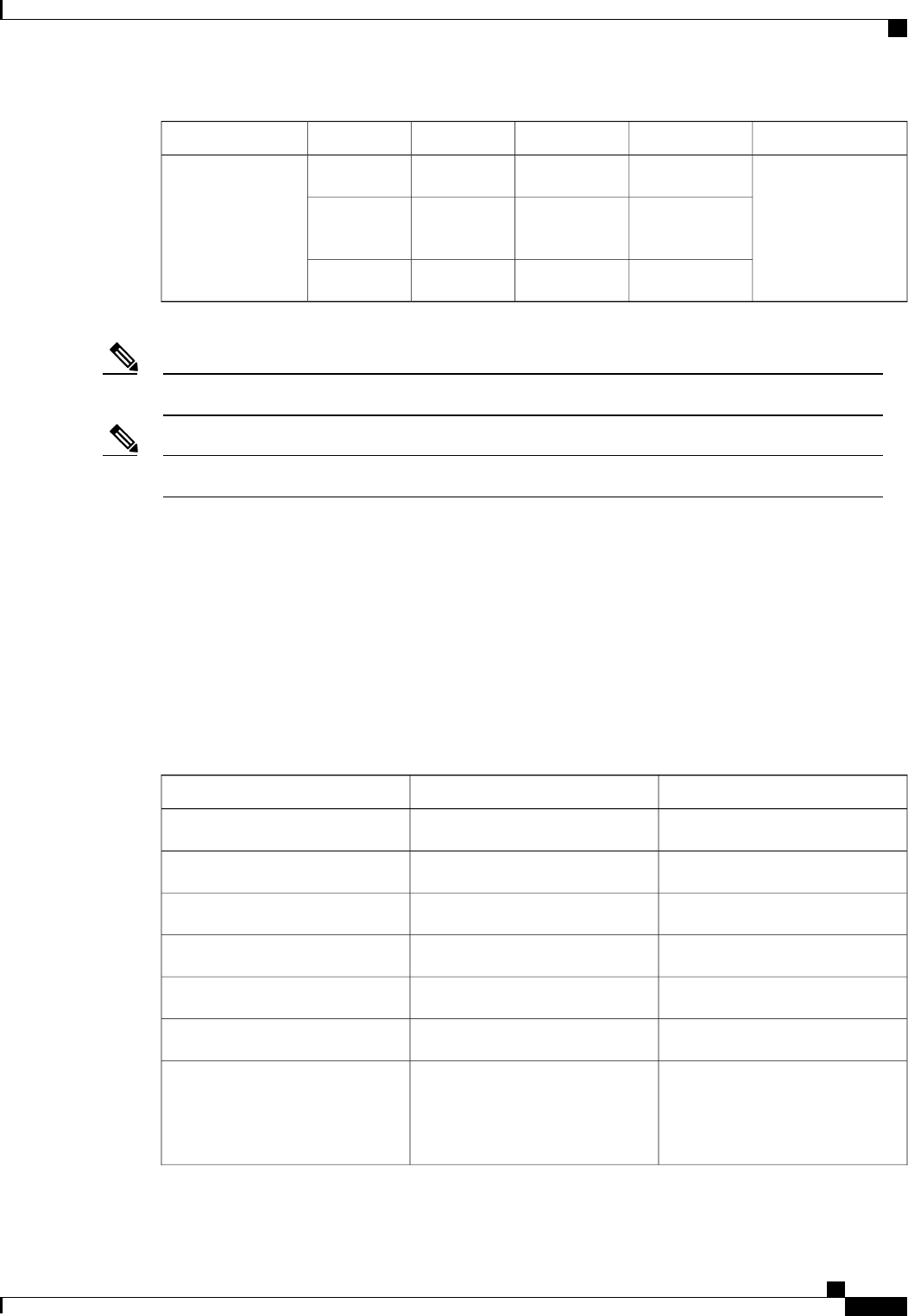
Call buttonSoftkey 4Softkey 3Softkey 2Softkey 1Call State
On hookMore1AppsEnd CallHoldConnected
(multiple calls)
More2TransferSwap or
Calls
Contacts
TopParkConfListConf
The ConfList softkey displays only if you are in a conference.Note
The Calls softkey displays when more than two calls are connected. Pressing Calls loads a call list.Note
Survivable Remote Site Telephony overview
If communication between the conference station and the Cisco Unified Communications Server is interrupted,
you receive an alert message on your phone. If you are on an active call, the call remains established, and you
enter a failover situation. This failover is the Survivable Remote Site Telephony (SRST) feature.
While in failover, not all the features of conference station are available. The following table describes typical
features and feature availability. For more information about feature availability during failover, contact your
system administrator.
Table 9: Feature support during Failover
NotesSupportedFeature
YesNew Call
YesEnd Call
YesRedial
YesAnswer
YesHold
YesResume
This also applies to other
forwarding features such as, Call
Forward All, Call Forward Busy
and Call Forward No Answer.
NoCall Forward
Cisco Unified IP Phone 8831 User Guide for Cisco Unified Communications Manager 9.3
39
Calling Features
Survivable Remote Site Telephony overview

NotesSupportedFeature
YesConference
The Active Calls softkey does not
display.
NoConference to Active Calls (Join)
NoConference List
Consult only.YesTransfer
NoTransfer to Active Calls (Direct
Transfer)
YesAuto Answer
YesCall Waiting
YesCaller ID
YesAudible Message Waiting Indicator
Conference is the only feature
supported.
YesUnified Session Presentation
Your voicemail will not be
synchronized with other users in
the Cisco Unified Communications
Manager cluster.
YesVoicemail
YesSpeed Dial
The Divert softkey does not
display.
NoTo Voicemail (Divert)
The Park softkey does not display.NoPark Monitoring
You see the message “That feature
is not currently available.”
NoBarge
Message count badges do not
appear on the phone screen.
Only the Message Waiting icon
displays.
NoEnhanced Message Waiting
Indication
The softkey does not display.NoDirected Call Park
Calls remain on hold indefinitely.NoHold Reversion
Calls appear as Local Hold calls.NoRemote Hold
Cisco Unified IP Phone 8831 User Guide for Cisco Unified Communications Manager 9.3
40
Calling Features
Survivable Remote Site Telephony overview

NotesSupportedFeature
The Meet Me softkey does not
display.
NoMeet Me
The softkey causes no action.NoPickUp
The softkey causes no action.NoGroup PickUp
The softkey causes no action.NoOther PickUp
The softkey causes no action.NoMalicious Call ID
The softkey causes no action.NoQRT
The softkey causes no action.NoMobility
The softkey causes no action.NoPrivacy
The Call Back softkey does not
display.
NoCall Back
When the conference station loses connectivity, it may display a message similar to this: SRST. Some
features unavailable.
Answer
Answer allows you to answer the oldest call that is available on the conference station, including Hold Reversion
and Park Reversion calls that are in an alerting state. Incoming calls are always given priority over Held or
Park Reversion calls.
When you get a call, you see a notification on the conference station screen. The call notification remains
visible for a preset amount of time. If there are multiple, simultaneous incoming calls, an incoming call list
window is displayed, and you can select which call to answer.
To answer a call, press Answer or press the Call key.
If an incoming call has been call forwarded from another phone or conference station, you may see additional
information to identify that the call has been forwarded. Your system administrator controls the amount of
additional information displayed. Additional information can identify the person who forwarded the call to
you and the caller information.
When you receive a call, the phone number that displays on the screen contains the string of digits that you
can dial to contact the caller. The digit string can contain the following digits, if required:
•Code to obtain an outside line (for example, if you have to dial 9)
•Long distance code
•Area code
•City code
Cisco Unified IP Phone 8831 User Guide for Cisco Unified Communications Manager 9.3
41
Calling Features
Answer

•Telephone number
The conference station saves the complete digit string in the call history, and you can save the number in your
Personal Address Book.
Call Back
Call Back allows you to receive an audio and a visual notification on your conference station when a busy or
unavailable party becomes available.
For more information, contact your system administrator.
Set Up Call Back notification
Procedure
Step 1 Press Call back while listening to the busy tone or ring sound.
A confirmation screen displays on the phone.
Step 2 Press Exit to exit the confirmation screen.
Your phone alerts you when the line is free.
Step 3 Press Call to place the call again.
Call Forward
Call Forward allows you to forward incoming calls from the conference station to another number.
There are two types of call forwarding features that the system administrator can set up for the conference
station:
•Unconditional call forwarding (Call Forward All): Applies to all calls that you receive.
•Conditional call forwarding (Call Forward No Answer, Call Forward Busy, Call Forward No Coverage):
Applies to certain calls that you receive.
If configured, you can set up Call Forward All from the conference station. Call Forward All can also be
accessed remotely from your User Options web pages. Conditional call forwarding rules can only be accessed
from your User Options web pages.
When forwarding calls from your conference station:
•Enter the call forward target number exactly as you would dial it from the conference station. For
example, enter an access code or the area code, if necessary.
•Call forwarding is line specific. If a call reaches you on a phone-line where call forwarding is not enabled,
the call will ring as usual.
•See your system administrator for details about the following configurable call forward options:
Cisco Unified IP Phone 8831 User Guide for Cisco Unified Communications Manager 9.3
42
Calling Features
Call Back

◦Allow calls placed from the call forward target number to the conference station to ring through,
rather than be forwarded.
◦Prevent you from creating a call forward loop or exceeding the maximum number of links in a call
forwarding chain.
Forward calls
Procedure
Step 1 Press Fwd All.
Step 2 Enter the target phone number.
Depending on how your voicemail system is set up, you may be able to press Msgs to forward all calls to
voicemail.
A visual confirmation is displayed the screen while call forwarding is active.
Step 3 To cancel call forwarding, press Fwd OFF.
Step 4 To forward calls remotely, or to set conditions on fall forwarding, go to your User Options Web pages.
Call Park
Call Park allows you to use the conference station to park (temporarily store) a call. The parked call can be
retrieved from another phone in the Cisco Unified Communications Manager system, such as a phone at a
coworker’s desk or in a conference room.
The parked call is retrieved by entering the parking number for the call into another phone in the Cisco Unified
Communications Manager system.
Your system administrator sets up the parking number for the conference station.
Park call
Procedure
Step 1 During a call, press the Park.
The conference station screen displays the call park number where the system stored your call.
Step 2 Note the call park number displayed on the screen. This number is used to retrieve the call.
You have a limited time to retrieve a parked call before it reverts to ringing at the original number.
Step 3 From any other Cisco Unified IP Phone or Conference Station in your network, enter the call park number to
retrieve the call.
Cisco Unified IP Phone 8831 User Guide for Cisco Unified Communications Manager 9.3
43
Calling Features
Forward calls

Call Pickup
Call Pickup allows you to answer a call that is ringing on a coworker’s phone by redirecting the call to your
phone.
You might use Call Pickup if you share call-handling tasks with coworkers.
There are three ways you can pick up a call:
•Pickup: Allows you to answer a call that is ringing on another phone within your call pickup group.
If multiple calls are available for pick up, the conference station picks up the oldest call first.
•Group Pickup: Allows you to answer a call on a phone that is outside your call pickup group by:
◦Using a group pickup number that is provided by your system administrator.
◦Dialing the number of the ringing phone.
•Other Pickup: Allows you to answer a call that is ringing on another phone within in your call pickup
group or in an associated call pickup group.
Your system administrator sets up the call pickup group you are in, and sets the call pickup softkeys.
Answer call using Pickup
Procedure
Step 1 Press Pickup to transfer a ringing call within your pickup group to the conference station.
Step 2 If the call rings, press Answer to connect to the call.
Answer call using Group Pickup and Group Pickup Number
Procedure
Step 1 Press Group Pickup to answer a call on a phone outside your pickup group.
Step 2 Enter the group pickup number.
Step 3 If the call rings, press Answer to connect to the call.
Cisco Unified IP Phone 8831 User Guide for Cisco Unified Communications Manager 9.3
44
Calling Features
Call Pickup

Answer call using Group Pickup and phone number
Procedure
Step 1 Press Group Pickup.
Step 2 Enter the number of the phone line with the call that you want to pick up.
For example, if the call is ringing on line 12345, enter 12345.
Step 3 If the call rings, press Answer to connect.
Answer call using Other Pickup
Procedure
Step 1 Press OPickup to transfer a call in your pickup group or in an associated group to the conference station.
Step 2 If the call rings, press Answer to connect.
cBarge
The cBarge feature allows you to add yourself to a call on a shared line and create a standard (ad hoc)
conference.
Join conference on shared line
Procedure
Press cBarge.
You may need to press More first.
Conference
Conference allows you to talk simultaneously with multiple parties.
When you are talking on a call, use Conference to dial another party and add them to the call.
Before completing a conference procedure, you can press Cancel to cancel the procedure.
Cisco Unified IP Phone 8831 User Guide for Cisco Unified Communications Manager 9.3
45
Calling Features
Answer call using Group Pickup and phone number

As the conference host, you can remove individual participants from the conference. You can also view a list
of participants.
The conference ends when all the participants hang up.
Add third party to conference
Before You Begin
Before you can add a party to the conference, you must be on an active call and not on hold.
Procedure
Step 1 Press Conf.
Step 2 Enter the phone number, fast dial code, or speed dial number for the party you want to add.
If you have several calls on hold, you can press Calls to bring up a caller list and add a caller to the conference.
Step 3 After the new party answers, press Conf.
The conference begins.
Step 4 Press Conf again.
Step 5 (Optional) Repeat these steps to add more parties, if desired.
View conference participants
Procedure
While in a conference, press ConfList to view a list of the last 16 participants who have joined the conference.
The maximum number of participants that can be displayed is 16. If there are more than 16 participants, only
the most recent 16 participants to join are displayed
Remove conference participants
Procedure
Step 1 While in a conference, press ConfList to view a list of participants.
Step 2 Highlight the participant that you want to remove, then press Remove.
Only the most recent 16 conference participants are
displayed.
Note
Cisco Unified IP Phone 8831 User Guide for Cisco Unified Communications Manager 9.3
46
Calling Features
Add third party to conference

Divert
Divert allows you to send an active or ringing call to your voicemail system or to a predetermined phone
number. Your system administrator configures this feature and sets the receiving phone number.
Divert call
Procedure
Press Divert to send an active call, an incoming call, or a held call to either your voicemail system or to a
predetermined phone number set up by your system administrator.
Do Not Disturb
Do Not Disturb (DND) allows you to turn off notification of incoming calls. The ringer, as well as audible
and visual notifications can be turned off.
Depending on how your administrator has configured this feature, incoming calls are either immediately
rejected, or the caller information displays on screen.
The DND softkey is configured by the system administrator, but you can change your DND options from
your User Options web pages.
DND interacts with other types of calls:
•If both DND and Call Forward All are enabled, calls are forwarded without any visual or audible
confirmation.
•DND does not affect priority calls.
Turn DND on and off
Procedure
Step 1 Press DND to turn on DND.
Visual confirmation displays briefly.
Step 2 Press DND again to turn off DND.
Visual confirmation displays briefly.
Cisco Unified IP Phone 8831 User Guide for Cisco Unified Communications Manager 9.3
47
Calling Features
Divert

Enhanced Room Coverage
Optional microphone extension kits provide enhanced room coverage that can be further expanded by linking
two units together in Linked Mode. This feature allows you to use the conference station in a larger room, or
to enhance the audio and voice experience for larger groups of in-person attendees.
When two conference station base units are linked together to expand the audio coverage area, one conference
station acts as the primary device, and the other sound base is the dependant or secondary device. In Linked
Mode, the primary base station supports one or two wireless microphones, or it supports one wired microphone.
The secondary unit supports only one wired microphone; a wireless microphone cannot be connected to a
secondary Sound Base. You cannot mix microphone types on the devices. Consult the following tables for
allowable configurations.
Table 10: Deployment configurations for Enhanced Room Coverage with a single phone
Wireless Extension MicrophoneWired Extension Microphone
--1 or 2Number and type of
connected microphones 1 or 2--
Table 11: Deployment configurations for Enhanced Room Coverage in Linked Mode
Secondary Sound BasePrimary Sound Base
----Wired Extension
Microphone
1--Wired Extension
Microphone
--1Wired Extension
Microphone
11Wired Extension
Microphone
----Wireless Extension
Microphone
--1 or 2Wireless Extension
Microphone
In Linked Mode, voice, dial tone, ringer and base LED features are synchronized between the two devices.
A daisy cable is required to connect two Sound Base units in Linked Mode.Note
Linked Mode, on page 23
Cisco Unified IP Phone 8831 User Guide for Cisco Unified Communications Manager 9.3
48
Calling Features
Enhanced Room Coverage

Wireless Microphone menu
The Wireless Microphone menu provides options for setting the pairing and range options for the wireless
expansion microphones. A maximum of two wireless microphones can be paired to the conference station at
a time.
To access the Wireless Microphone menu, navigate to Apps >Admin Settings >Wireless Microphones.
The following table describes these options and, where applicable, explains how to change them.
Table 12: Wireless microphone options
To changeDescriptionOption
See Pair wireless microphone, on
page 49 or Unpair wireless
microphone, on page 50
The channel that can be used to
pair the first microphone.
Wireless Microphone 1
See Pair wireless microphone, on
page 49 or Unpair wireless
microphone, on page 50
The channel that can be used to
pair the second microphone.
Wireless Microphone 2
Select Low, Medium or High, and
press Select. Or press Default to
select the default setting and press
Select.
Sets the baseband power and
effective RF range for the wireless
microphones.
The RF range can be set to
•Low
•Medium
•High
Wireless Microphone Range
Pair wireless microphone
Before You Begin
The microphone must be in the off state before you can pair it to the conference station. A microphone is off
if its LED is off. To turn off the wireless microphone, hold down the mic button until it turns solid red, then
release.
Procedure
Step 1 Choose Apps >Admin Settings >Wireless Microphones.
Step 2 Select either Wireless Microphone 1 or Wireless Microphone 2.
If the selected channel is available, a Pair microphone 1? or Pair microphone 2? prompt is
displayed, and the Pair softkey is available.
Cisco Unified IP Phone 8831 User Guide for Cisco Unified Communications Manager 9.3
49
Calling Features
Wireless Microphone menu

If a microphone is already linked to a particular channel, pairing cannot be initiated on the selected channel
and the dialog shows that the microphone is linked.
Step 3 Press Pair.
If the channel is ready to pair, the pairing process begins and a text message is displayed.
Step 4 Put the microphone that corresponds to the selected channel in pairing mode by pressing its Mute button until
the LED is solid red.
If pairing is successful the screen will revert to the Wireless Microphones Menu, and the message: Mic X
Paired Successfully! is displayed.
If pairing timed out or failed, the status is updated and you can cancel or retry.
Step 5 Press Cancel to revert to the wireless microphones menu.
Step 6 Press Retry to start the pairing process again.
Related Topics
Unpair wireless microphone, on page 50
Unpair wireless microphone
If you need to connect a wired microphone to the conference station, any wireless microphones must be
unpaired first. You can also use this procedure to unpair a microphone that is no longer in use.
This option is not available if the microphone is connected. To enable the unpair command, place the
wireless microphone in its charger or turn it off.
Note
Procedure
Step 1 Choose Applications >Admin Settings >Wireless Microphones.
Step 2 Select either Wireless Microphone 1 or Wireless Microphone 2.
If the selected channel is paired, the Unpair softkey is available.
Step 3 Press Unpair.
A verification prompt with the options to Cancel or Unpair is displayed.
Step 4 Press Unpair to continue to unpair the microphone.
The microphone channel's registration information in the base is deleted. If the microphone channel's status
if viewed in phone info menu the status value and RFID will be empty.
Step 5 Press return to revert to the wireless microphones menu and stop the process.
Related Topics
Pair wireless microphone, on page 49
Cisco Unified IP Phone 8831 User Guide for Cisco Unified Communications Manager 9.3
50
Calling Features
Unpair wireless microphone

Extension Mobility
Cisco Extension Mobility (EM) allows you to temporarily configure a Cisco Unified IP Phone or Conference
Station to use as your own. Once you log in to EM, the new device adopts your user profile, features, established
services, and web-based settings. Your system administrator must configure EM for you.
The Cisco Extension Mobility ChangePIN feature allows you to change your PIN from your Cisco Unified
IP Phone.
Note •EM automatically logs you out after a certain amount of time. Your system administrator establishes
this time limit.
•Changes that you make to your EM profile from your User Options web pages take effect immediately
if you are logged in to EM on the physical device; otherwise, changes take effect the next time you
log in.
•Changes that you make to a phone or conference station from your User Options web pages take
effect immediately if you are logged out of EM; otherwise, changes take effect after you log out.
•Local settings controlled by the phone are not maintained in your EM profile.
Enable Extension Mobility
Procedure
Step 1 Press Apps.
Step 2 Select EM Service.
Step 3 Enter your user ID and PIN.
The user ID and PIN are provided by your system administrator
Step 4 If prompted, select a device profile.
Step 5 To sign out, press Apps.
Step 6 Select Services.
Step 7 Select EM Service.
Step 8 At the prompt, press Yes.
Fast Dial
Fast Dial allows you dial a phone number from the Fast Dial service on your phone. Before you can use Fast
Dial on your phone, you must set up Fast Dial on your User Options web pages.
Cisco Unified IP Phone 8831 User Guide for Cisco Unified Communications Manager 9.3
51
Calling Features
Extension Mobility

Related Topics
User Options web pages, on page 65
Place call using Fast Dial
Before you can use Fast Dial on the conference station, it must be set up on your User Options web pages.
Procedure
Step 1 Press Contacts.
Step 2 Sign in to Personal Directory.
Step 3 Select Personal Fast Dials.
Step 4 Select a fast dial code and then press Call.
Hold
Hold allows you to put an active call into a held state. Your phone allows one active call at a time; other calls
are put on hold.
Hold active call
Procedure
Step 1 To put an active call on hold, press Hold.
The Hold icon is displayed as a status icon.
Step 2 If there is only one call on hold and you are not on an active call, press Resume.
Step 3 If you are already on an active call, press Swap.
The holding call becomes active, and the active call is placed on hold.
Cisco Unified IP Phone 8831 User Guide for Cisco Unified Communications Manager 9.3
52
Calling Features
Place call using Fast Dial

Switch between active and multiple holding calls
Procedure
Step 1 If you are on an active call and there are multiple calls on hold, the Calls softkey becomes available and a
call list of holding calls is displayed on the screen.
Step 2 Use the navigation bar to highlight the call you want to make active. Press Resume.
The current active call is placed on hold and the selected call is now active.
Hold active call and answer new incoming call
Procedure
Pressing answer Answer while on an active call automatically places the active call on hold and answers the
incoming call
Hold Reversion
Hold Reversion provided a notification that a call is left on hold. Hold reversion notifications are similar to
new call notifications.
Depending on the configuration of the conference station, you may see one or more of the following:
•An animated icon that appears as an incoming call for 2 seconds and then as a hold icon for 2 more
seconds.
•A single ring that repeats at regular intervals.
•The Call button on the DCU flashes green.
•The LEDs on the sound base flash green.
Respond to Hold Reversion notification
Procedure
Press Answer
Cisco Unified IP Phone 8831 User Guide for Cisco Unified Communications Manager 9.3
53
Calling Features
Switch between active and multiple holding calls

Meet Me Conference
If enabled by your system administrator, the Meet Me Conference feature allows you to call a predetermined
number at a scheduled time to host or join a Meet Me conference.
The Meet Me conference begins when the host connects. Participants who call the conference before the host
has joined hear a busy tone and must dial again.
The conference ends when all participants hang up; the conference does not automatically end when the
host disconnects.
Note
Host Meet Me Conference
Procedure
Step 1 Obtain a Meet Me phone number from your system administrator.
Step 2 Distribute the Meet Me phone number to participants.
Step 3 When you are ready to start the meeting, press MeetMe.
You may need to press More first.
Step 4 Dial the Meet Me phone number.
Join Meet Me Conference
Procedure
Step 1 Dial the Meet Me phone number provided by the conference host.
Step 2 If you hear a busy tone, the host has not yet joined the conference. In this case, disconnect and try your call
again.
Mobile Connect
Mobile Connect allows you to use your mobile phone to handle calls associated with the conference station
phone number.
To set up Mobile Connect, use the User Options web pages to set up remote destinations and create access
lists to allow or block calls from specific phone numbers from being passed to the remote destinations.
Cisco Unified IP Phone 8831 User Guide for Cisco Unified Communications Manager 9.3
54
Calling Features
Meet Me Conference

When you enable Mobile Connect:
•The conference station and remote destinations receive calls simultaneously.
•When you answer the call on the conference station, the remote destinations stop ringing, disconnect,
and display a missed call message.
•When you answer the call on one remote destination, the other remote destinations and the conference
station stop ringing, are disconnected, and a missed call message is shown on the other remote destinations.
Enable Mobile Connect
Procedure
Step 1 Press More.
Step 2 Press Mobility to display the current remote destination status (Enabled or Disabled).
Step 3 Press Select to change the status.
Step 4 Press Exit.
Switch IP phone call to mobile phone
Procedure
Step 1 Press More.
Step 2 Press Mobility.
Step 3 Select To mobile.
Step 4 Answer the in-progress call on your mobile phone.
You cannot use the conference station for any other calls while this call is still in progress.
The Call button LED is solid red, and the calling party number appear on the phone display.
Cisco Unified IP Phone 8831 User Guide for Cisco Unified Communications Manager 9.3
55
Calling Features
Enable Mobile Connect

Switch mobile call to IP phone
Procedure
Step 1 Press Call on the conference station.
Step 2 Hang up the call on your mobile phone to disconnect the mobile phone, but not the call.
Step 3 Press Resume on the conference station within five to 10 seconds and start talking on the conference station.
Monitoring and Recording
The Monitoring and Recording feature allows you to monitor and record calls. Your system administrator
enables this feature, which can be set up for automatic recording of all calls or recording of calls on a per-call
basis.
You can start or stop a recording by pressing the Record softkey on your phone.
Users might receive audible alerts during call monitoring and recording. By default, the person who monitors
the call and records it does not receive an audible alert.
Secure monitoring and recording is also available. For details on this aspect of the feature, see your system
administrator.
Multiple calls per line
The conference station has a single line and supports a maximum of 6 calls. Unless you are in a conference,
only one call can be connected at any time; other calls are automatically placed on hold.
Multiple incoming calls
If there is a second incoming call on the line, while the first call is ringing, a navigable incoming call list
window is displayed on the screen. The call list windows updates automatically if there are additional incoming
calls, or if an incoming call is cancelled.
Call ended on line with multiple calls
After a call is completed, if there are still multiple calls on the line, the next call in the call list gains focus.
Outbound call maximum
The maximum number of outbound calls on the conference station is 6.
Cisco Unified IP Phone 8831 User Guide for Cisco Unified Communications Manager 9.3
56
Calling Features
Switch mobile call to IP phone

Answer second call on same line
Procedure
To answer a second call on your conference station line, press Answer.
Any active call is placed on hold, and the second call is answered.
Switch between calls on same line
Procedure
Step 1 Press Swap to switch between two calls on the same line.
Step 2 If there are more than two calls on the line, select a call from the call list, and press Resume.
Create conference with two calls on same line
Procedure
Step 1 With two connected calls on the same line, select a call to make it the active call.
The second call is put on hold.
Step 2 Press Conference.
Step 3 Press Calls to view the call list and select the caller to add to the conference.
Step 4 Wait for the call to connect.
Step 5 Press Conference to add the participant to your call.
The conference begins.
Step 6 (Optional) Repeat to add additional participants.
Transfer two calls on same line
Before You Begin
You must be on an active call to transfer calls.
Cisco Unified IP Phone 8831 User Guide for Cisco Unified Communications Manager 9.3
57
Calling Features
Answer second call on same line

Procedure
Step 1 Press Transfer.
Step 2 Enter phone number or press a speed-dial button for the transfer destination.
When you have reached maximum number of calls for your line, pressing Transfer allows you to select the
calls from a list of calls on the line.
Step 3 Wait for the recipient to answer.
Step 4 Press Transfer again.
Shared Line
If the conference station is registered on a shared line, you can handle multiple calls in the following ways:
•If there are two or more remote calls on the shared line, the caller ID field on the conference station
indicates the number of remote calls on the line, and the state of the call. Press Calls to display the call
list window.
•If at least one call on the shared line is on hold, the Call button LED flashes red. Press Resume to make
the call active, or use the navigation bar to choose a call to resume from the call list. For example, if a
remote call on the shared line is placed on hold, the Call button on your conference station will flash
red.
Mute
Mute allows you to block audio input for the conference station, so that you can hear other parties on the call
but they cannot hear you.
The conference station can be muted in two ways:
•Press the Mute button on the Sound Base.
•Press the Mute button on the DCU.
If connected, the optional extension microphones can also be used to mute the conference station. In Linked
Mode, the Mute button on the secondary sound base behaves the same as the Mute button on the primary unit.
LED indicators on both the sound base and the DCU indicate the mute status of the conference station:
•Solid, red base LEDs and red base Mute button: muted.
•Solid, red DCU Mute button: muted.
Cisco Unified IP Phone 8831 User Guide for Cisco Unified Communications Manager 9.3
58
Calling Features
Shared Line

Mute IP phone sound base
Procedure
Step 1 Press Mute to turn Mute on.
The Mute button is backlit by a solid, red light, and the sound base LEDs are red.
Step 2 Press Mute again to turn Mute off.
Mute IP phone DCU
Procedure
Step 1 Press Mute to turn Mute on.
The Mute button is backlit by a solid, red light, and a mute icon displays on the screen.
Step 2 Press Mute again to turn Mute off.
On-Hook dialing
On-hook dialing allows you to enter a phone number before getting a dial tone and then press the Call button
to complete the call.
Dial number on-hook
Procedure
Step 1 Enter or speed dial a phone number.
Step 2 Press Dial.
Plus Dialing
Plus Dialing allows you to press and hold the star (*) key for at least 1 second to insert a plus (+) sign as the
first digit in a phone number when dialing an international number.
Cisco Unified IP Phone 8831 User Guide for Cisco Unified Communications Manager 9.3
59
Calling Features
Mute IP phone sound base

A phone number with the + sign in it can be selected and dialed without the need to add digits for international
calls.
Dial international number
Before You Begin
Before dialing an international call or using Plus Dialing, enter any local access code, such as 8 or 9 if
applicable.
Procedure
Step 1 Press and hold star (*) for at least 1 second.
The plus (+) sign displays as the first digit in the phone number.
The corresponding key tone stops to indicate that the * has changed to a + sign.
Step 2 Dial the international number, including the country code.
Privacy
If configured, the Privacy feature allows you to prevent others who share your line from seeing information
about your calls. Your system administrator configures this feature.
If the phone that shares your line has Privacy enabled, you can make and receive calls using the shared line
as usual.
Enable privacy on shared line
Before You Begin
Before you can use this feature, it must enabled by your system administration.
Procedure
Step 1 Press More.
Step 2 Use the navigation bar and Select button to scroll to the Private softkey.
•Press Private to enable this feature.
•Press Private to disable this feature if it is currently enabled.
Cisco Unified IP Phone 8831 User Guide for Cisco Unified Communications Manager 9.3
60
Calling Features
Dial international number

Quality Reporting Tool
Your system administrator may temporarily configure the conference station with the Quality Reporting Tool
(QRT) to troubleshoot performance problems. Invoking the QRT reports a problem with the current call to
the system administrator.
Report IP phone problems
Procedure
Step 1 Press More.
Step 2 Use the navigation bar and Select button to locate and select QRT.
The information is sent to your system administrator.
Redial
Redial allows you to call the most recently dialed phone number.
Redial number
Procedure
To redial the last number you called, press Redial.
Shared lines
Shared lines allow you to use one phone number for multiple devices.
A shared line is useful if you have multiple devices and want one phone number, share call-handling tasks
with coworkers, or handle calls on behalf of a manager. The other devices that share your line are referred to
as remote devices, and a call that is being handled by a device that shares your line is referred to as a remote
call.
When a call comes in on the shared line, the conference station rings and your coworker's device rings. Either
you or your coworker can answer the call, place the call on hold, or transfer the call.
The Call button on the DCU has an LED that indicates the call state. For example:
•Remote in use: solid red LED.
•Remote hold: pulsing red LED
Cisco Unified IP Phone 8831 User Guide for Cisco Unified Communications Manager 9.3
61
Calling Features
Quality Reporting Tool

Your call history shows the status for all calls on the shared line. For example, if a call rings on a shared line
and you answer the call, your coworkers who share the line will see that the call was answered remotely. Your
call history identifies calls that were Placed, Received, or Missed.
Speed Dial
Speed Dial features allow you to quickly place a call using pre-configured codes to place a call, or by selecting
an item from the Call History list. Before you can use speed dial features on the conference station, you must
set up Speed Dial on your User Options web pages. The conference station allows 10 speed dial entries.
The conference station supports these speed dial features:
•Speed-dial codes: Allows you to dial a phone number from a code (sometimes referred to as abbreviated
dialing or fast dialing).
Related Topics
Speed Dial setup on Web, on page 70
Place call using speed dial codes
Before You Begin
Before you can use speed dial codes on the conference station, you must set up the codes on your User Options
web pages.
Procedure
To place a call, enter the speed dial code and press the Speed Dial.
Transfer
Transfer allows you to redirect a connected call from the conference station to another number.
Before completing a transfer procedure, you can press the Cancel to cancel the procedure.
Transfer call to another number
Before You Begin
The call must be active to be transferred.
Cisco Unified IP Phone 8831 User Guide for Cisco Unified Communications Manager 9.3
62
Calling Features
Speed Dial

Procedure
Step 1 Press Transfer.
Step 2 Enter the destination number or press a speed-dial button.
Step 3 Wait for the recipient to answer.
Step 4 Press Transfer again.
The transfer completes.
WebDialer
WebDialer allows you to click-to-dial contacts from the Cisco Unified CM Directory. Your system administrator
sets up this feature for you.
Use WebDialer with Cisco directory
Procedure
Step 1 Sign in to your User Options web pages.
Step 2 Select User Options >Directory and search for a coworker.
Step 3 Select the number that you want to dial.
Step 4 If this is your first time using WebDialer, review the preferences on the Make Call window.
Step 5 Select Dial.
The call is now placed on your phone.
Step 6 To end a call, select Hang up from the Make Call window, or press End Call on your phone.
Use WebDialer with another online corporate directory
Procedure
Step 1 Sign in to a WebDialer-enabled corporate directory and search for coworkers.
Step 2 Select the number that you want to dial.
Step 3 When prompted, enter your user ID and password.
Step 4 If this is your first time using WebDialer, review the preferences on the Make Call window.
Step 5 Select Dial.
Cisco Unified IP Phone 8831 User Guide for Cisco Unified Communications Manager 9.3
63
Calling Features
WebDialer

The call is now placed on your phone line.
Step 6 To end a call, select Hang up in the Make Call window or press End Call on your conference station.
Change WebDialer preferences
Procedure
Step 1 Sign in to your User Option web pages.
Step 2 Initiate a call using WebDialer to access the Make Call window.
The Make Call window displays the first time that you use WebDialer (after you select the number that you
want to dial).
Step 3 Select one of the following options from the Make Call window:
•Preferred language: Determines the language used for WebDialer settings and prompts.
•Use preferred device: Identifies the Cisco Unified IP Phone (calling device) and directory number (calling
line) that you use to place WebDialer calls.
If you have one phone with a single line, the appropriate phone and line are automatically selected.
Step 4 If the phone and line are not automatically selected, choose a phone or line.
If you have more than one phone of the same type, the list identifies the phone by device type and MAC
address. To display the MAC address on your phone, select Apps >Phone Information.
Step 5 If you have an Extension Mobility profile, select Extension Mobility from the Calling Device drop-down
menu in the the Make Call window.
•Do not display call confirmation: If selected, the WebDialer Make Call window does not display the
next time WebDialer is used. Calls will automatically dial after you select a contact from the Cisco
directory.
•Disable Auto Close: If selected, the call window does not close automatically after 15 seconds.
Cisco Unified IP Phone 8831 User Guide for Cisco Unified Communications Manager 9.3
64
Calling Features
Change WebDialer preferences

CHAPTER 7
User Options web pages
Your Cisco Unified IP Phone 8831 is a network device that can share information with other network devices
in your company, including your personal computer. You can use your computer to log in to your User
Options web pages, where you can control features, settings, and services for your conference station.
This section describes how to log in and select a conference station.
•Sign in and out of User Options web pages, page 65
•Select device from User Options web page, page 66
•Features and services setup on Web, page 66
Sign in and out of User Options web pages
Before you can access any of your user options, such as Speed Dial or Personal Address Book, you must sign
in. When you are finished using the User Options web pages, you must sign out.
In some cases, you can access your User Option web pages without having to sign in. For more information,
contact your system administrator.
Procedure
Step 1 Obtain the User Options URL, user ID, and default password from your system administrator.
Step 2 Open a web browser on your computer and enter the URL.
Step 3 If prompted to accept security settings, select Yes or Install Certificate.
Step 4 Enter your user ID in the Username field.
Step 5 Enter your password in the Password field.
Step 6 Select Login.
The Cisco Unified CM User Options home page displays. From this page you can select User Options to
select a device, access User Settings, Directory features, your Personal Address Book, and Fast Dials.
Step 7 To sign out of user options, select Logout.
Cisco Unified IP Phone 8831 User Guide for Cisco Unified Communications Manager 9.3
65

Select device from User Options web page
Procedure
Step 1 Log in to your User Options web pages, and then choose User Options >Device.
The Device Configuration page appears.
Step 2 If you have multiple conference stations assigned to you, verify that the appropriate conference station is
selected. If necessary, choose another conference station from the Name drop-down list.
From the Device Configuration page, you can access conference station-specific options, such as Line Settings,
Speed Dials, Phone Services, and Service URL.
Step 3 To return to the Device Configuration page from another page, choose User Options >Device.
Features and services setup on Web
This section describes how to configure features and services from your User Options web pages after logging
in.
Related Topics
Sign in and out of User Options web pages, on page 65
Personal directory on Web
The Personal Directory feature set that you can access on your computer consists of:
•A Personal Address Book (PAB)
•Fast Dials
•Cisco Unified Communications Manager Address Book Synchronizer
You can also access PAB and Fast Dials from the conference station.
Related Topics
Personal Directory, on page 28
Personal Address Book on Web
This section describes how to use your PAB from your User Options web pages.
Related Topics
Sign in and out of User Options web pages, on page 65
Cisco Unified IP Phone 8831 User Guide for Cisco Unified Communications Manager 9.3
66
User Options web pages
Select device from User Options web page

Add new Personal Address Book entry
Procedure
Step 1 Choose User Options >Personal Address Book.
Step 2 Click Add New.
Step 3 Enter information for the entry.
Search Personal Address Book entry
Procedure
Step 1 Choose User Options >Personal Address Book.
Step 2 Specify search information, and then click Find.
Edit Personal Address Book entry
Procedure
Step 1 Choose User Options >Personal Address Book.
Step 2 Search for the PAB entry you want to edit.
Step 3 Click the nickname for the PAB entry you want to edit.
Step 4 Edit the entry, and then click Save.
Delete Personal Address Book entry
Procedure
Step 1 Choose User Options >Personal Address Book.
Step 2 Search for the PAB entry you want to delete.
Step 3 Check the checkbox next to the PAB entry you want to delete.
Step 4 Click Delete Selected.
Cisco Unified IP Phone 8831 User Guide for Cisco Unified Communications Manager 9.3
67
User Options web pages
Personal directory on Web

Fast Dials on Web
This section describes how to assign Fast Dials from your User Options web pages.
Tips
•You can create up to 500 fast dial and PAB entries.
•When you create a new fast dial entry without using a PAB entry, the fast dial entry is labeled “Raw”in
your User Options web pages. The entry does not display a configurable text label and does not have a
matching entry in your PAB.
Related Topics
Sign in and out of User Options web pages, on page 65
Assign Fast Dial code to Personal Directory entry
Procedure
Step 1 Sign in to Personal Directory. (Use the navigation bar and button to scroll and select.)
Step 2 Enter the name information and press the Submit softkey.
Step 3 Select the name, then press the FastDial softkey.
Step 4 Select a number and press the Select softkey.
Step 5 Press the Next softkey.
Step 6 Press the Assign softkey for a new fast-dial code that you want to assign to the number.
Assign Fast Dial code to phone number
Procedure
Step 1 Sign in to your User Options web page.
Step 2 Select User Options >Fast Dials.
Step 3 Select Add New.
Step 4 Change the Fast Dial code, if desired.
Step 5 Enter a phone number.
Step 6 Select Save.
Cisco Unified IP Phone 8831 User Guide for Cisco Unified Communications Manager 9.3
68
User Options web pages
Fast Dials on Web

Search for Fast Dial entry
Procedure
Step 1 Sign in to your User Options web page.
Step 2 Select User Options >Fast Dials.
Step 3 Specify search information and select Find.
Edit Fast Dial phone number
Procedure
Step 1 Sign in to your User Options web page.
Step 2 Select User Options >Fast Dials.
Step 3 Search for the Fast Dial entry that you want to edit.
Step 4 Select a component of the entry.
Step 5 Change the phone number.
Step 6 Select Save.
Delete Fast Dial Personal Address Book entry
Procedure
Step 1 Sign in to your User Options web page.
Step 2 Search for a Fast dial entry.
Step 3 Select one or more entries.
Step 4 Select Delete Selected.
Address book synchronization tool
You can use the Cisco Unified Communications Manager Address Book Synchronizer to synchronize your
existing Microsoft Windows Address Book (if applicable) with your PAB. Entries from your Microsoft
Windows Address Book will then be accessible on your conference station and your User Options web pages.
Your system administrator can give you access to the synchronizer and provide detailed installation instructions.
Cisco Unified IP Phone 8831 User Guide for Cisco Unified Communications Manager 9.3
69
User Options web pages
Fast Dials on Web

Speed Dial setup on Web
Depending on configuration, the conference station can support several Speed Dialing features:
•Speed Dials
•Abbreviated Dials
•Fast Dials
This section describes how to set up speed dialing features from your User Options web pages.
Related Topics
Speed Dial, on page 62
Sign in and out of User Options web pages, on page 65
Fast Dials on Web, on page 68
Set up speed dial codes
Procedure
Step 1 On your User Options web page, select User Options >Device.
Step 2 Select a phone from the Name drop-down menu.
Step 3 Select Speed Dials.
Step 4 In the Abbreviated Dial Settings area, enter a number and label for a speed-dial code.
Step 5 Select Save.
Set up Abbreviated Dialing codes
Procedure
Step 1 Choose User Options >Device.
Step 2 Choose a phone from the Name drop-down menu.
Step 3 Click Speed Dials.
Step 4 Enter a number and label for an Abbreviated Dialing code.
Step 5 Click Save.
Cisco Unified IP Phone 8831 User Guide for Cisco Unified Communications Manager 9.3
70
User Options web pages
Speed Dial setup on Web

Phone services setup on Web
Conference station services can include special conference station features, network data, and web-based
information (such as stock quotes and movie listings). You must first subscribe to a conference station service
before accessing it on the conference station.
This section describes how to configure conference station services using your User Options web pages.
Related Topics
Sign in and out of User Options web pages, on page 65
Subscribe to service
Procedure
Step 1 On your User Options web page, select User Options >Device.
Step 2 Select a phone from the Name drop-down menu.
Step 3 Select Phone Services.
Step 4 Select Add New.
Step 5 Select a service from the drop-down list and select Next.
Step 6 (Optional) Change the service label or enter additional service information, if available.
Step 7 Select Save.
Search for services
Procedure
Step 1 On your User Options web page, select a device.
Step 2 Select Phone Services.
Step 3 Select Find.
Cisco Unified IP Phone 8831 User Guide for Cisco Unified Communications Manager 9.3
71
User Options web pages
Phone services setup on Web

Change or end services
Procedure
Step 1 On your User Options web page, search for services.
Step 2 Select one or more entries.
Step 3 Select Delete Selected.
Change service name
Procedure
Step 1 On your User Options web page, search for services.
Step 2 Select a service name.
Step 3 Change the information and select Save.
Access service on phone
Procedure
From the conference station, choose > Services.
User settings on Web
User settings include your password, PIN, and language (locale) settings.
Your PIN and password allow you to access different features and services. For example, use your PIN to log
in to Cisco Extension Mobility or Personal Directory on the conference station. Use your password to log in
to your User Options web pages and Cisco WebDialer on your personal computer. For more information, ask
your system administrator.
This section describes how to control your user settings from your User Options web pages.
Related Topics
Sign in and out of User Options web pages, on page 65
Cisco Unified IP Phone 8831 User Guide for Cisco Unified Communications Manager 9.3
72
User Options web pages
User settings on Web

Change browser password
Procedure
Step 1 Sign in to your User Options web pages.
Step 2 Select User Options >User Settings.
Step 3 Enter your Current Password.
Step 4 Enter your New Password.
Step 5 Reenter your new password in the Confirm Password field.
Step 6 Select Save.
Change PIN
Procedure
Step 1 Sign in to your User Options web pages.
Step 2 Select User Options >User Settings.
Step 3 Enter your Current PIN.
Step 4 Enter your New PIN.
Step 5 Reenter your new PIN in the Confirm PIN field.
Step 6 Select Save.
Change user options web page language setting
Procedure
Step 1 Sign in to your User Options web page.
Step 2 Select User Options >User Settings.
Step 3 In the User Locale area, select an item from the Locale drop-down list.
Step 4 Select Save.
Cisco Unified IP Phone 8831 User Guide for Cisco Unified Communications Manager 9.3
73
User Options web pages
User settings on Web

Change phone display language
Procedure
Step 1 Sign in to your User Options web page.
Step 2 Select User Options >Device.
Step 3 Select an item from the User Locale drop-down list.
Step 4 Select Save.
Line settings on Web
Line settings include call forward, voice message indicators, ring types, and line text labels that you set up
for your conference station.
By default, the ring type and line text label options do not display on your User Options web pages. See
your system administrator to set up these options so you can access them.
Note
This section describes the line settings you can update from your User Options web pages.
Related Topics
Sign in and out of User Options web pages, on page 65
Call Forward, on page 42
Preferences, on page 22
Set up Call Forward per line
Procedure
Step 1 On your User Options web page, select User Options >Device.
Step 2 Select a phone from the Name drop-down menu.
Step 3 Select Line Settings.
Step 4 If you have more than one directory number (line) assigned to your phone, select a line from the Line drop-down
menu.
Step 5 In the Incoming Call Forwarding area, select call forwarding settings for various conditions.
Step 6 Select Save.
Cisco Unified IP Phone 8831 User Guide for Cisco Unified Communications Manager 9.3
74
User Options web pages
Line settings on Web

Change voice message indicator setting per line
Procedure
Step 1 On your User Options web page, select User Options >Device.
Step 2 Select a phone from the Name drop-down menu.
Step 3 Select Line Settings.
Step 4 (Optional) If you have more than one directory number (line) assigned to your phone, select a line from the
Line drop-down menu.
Step 5 In the Message Waiting Lamp area, choose from various settings.
Step 6 Typically, the default message waiting setting prompts your phone to display a steady red light from the
handset light strip to indicate a new voice message.
Step 7 Select Save.
Change audible voice message indicator setting per line
Procedure
Step 1 On your User Options web page, select User Options >Device.
Step 2 Select a phone from the Name drop-down menu.
Step 3 Select Line Settings.
Step 4 If you have more than one directory number (line) assigned to your phone, select a line from the Line drop-down
menu.
Step 5 In the Audible Message Waiting Lamp area, choose from various settings.
Step 6 Select Save.
Change ring type
The “idle”ring setting pertains if you receive an incoming call when the conference station is idle. The
“consecutive”ring setting pertains if you receive an incoming call when the conference station is active.
Cisco Unified IP Phone 8831 User Guide for Cisco Unified Communications Manager 9.3
75
User Options web pages
Line settings on Web

Procedure
Step 1 On your User Options web page, select User Options >Device.
Step 2 If you have more than one device, select a device.
Step 3 Select Line Settings.
Step 4 In the Ring Settings area, choose a setting to tell the conference station how to indicate an incoming call.
Step 5 Select Save.
Update line text label displayed on called party phone
Procedure
Step 1 On your User Options web page, select User Options >Device.
Step 2 If you have more than one device, select a device.
Step 3 Select Line Settings.
Step 4 In the Line Text Label area, enter the text that will identify your directory number when you call another
conference station.
Step 5 If you do not specify a line text label, your directory number will display on the called party’s phone.
Step 6 Select Save.
Cisco WebDialer
Cisco WebDialer allows you to make calls on your conference station to directory contacts by clicking items
in a web browser. Your system administrator must set up this feature for you.
Use WebDialer with User Options directory
Procedure
Step 1 Log in to your User Options web pages.
Step 2 Choose User Options >Directory and search for a coworker.
Step 3 Click the number that you want to dial.
Step 4 If this is your first time using WebDialer, set up preferences on the Make Call page.
Step 5 Click Dial.
Step 6 The call is now placed on your phone.
Step 7 To end a call, click Hangup or hang up from your phone.
Cisco Unified IP Phone 8831 User Guide for Cisco Unified Communications Manager 9.3
76
User Options web pages
Cisco WebDialer

Use WebDialer with another online corporate directory (not User Options directory)
Procedure
Step 1 Log in to a WebDialer-enabled corporate directory and search for coworkers.
Step 2 Click the number that you want to dial.
Step 3 When prompted, enter your user ID and password.
Step 4 If this is your first time using WebDialer, set up preferences on the Make Call page.
Step 5 Click Dial.
The call is now placed on your phone.
Step 6 To end a call, click Hangup or hang up from your phone.
Log out of WebDialer
Procedure
Click the Logout icon in the Make Call or Hang Up page.
Set up, view, or change WebDialer preferences
Procedure
Step 1 Access the Make Call page.
The Make Call page appears the first time that you use WebDialer (after you click the number that you want
to dial).
Step 2 (Optional) Make changes to your settings.
Step 3 The Make Call page contains the following options:
•Preferred language: Determines the language used for WebDialer settings and prompts.
•Use preferred device: Identifies the Cisco Unified IP Phone (Calling device) and directory number
(Calling device or line) that you use to place WebDialer calls. If you have one phone with a single line,
the appropriate phone and line are automatically selected. Otherwise, choose a phone or line. If you have
more than one phone, it will be specified by device type and MAC address. To display the MAC address
on your phone, choose Settings >Network Configuration > MAC address.
If you have an Extension Mobility profile, you can select your Extension Mobility logged-in
device from the Calling device menu.
Note
Cisco Unified IP Phone 8831 User Guide for Cisco Unified Communications Manager 9.3
77
User Options web pages
Cisco WebDialer

•Use Extension Mobility: If selected, prompts Cisco WebDialer to use the conference station that is
associated with your Cisco Extension Mobility profile (if available).
•Do not display call confirmation: If selected, prompts WebDialer to suppress the Make Call page. This
page appears by default after you click a phone number in a WebDialer-enabled online directory.
•Disable Auto Close: If selected, prompts Cisco WebDialer to display the Hang Up page.
Cisco Unified IP Phone 8831 User Guide for Cisco Unified Communications Manager 9.3
78
User Options web pages
Cisco WebDialer

CHAPTER 8
Additional options
Your system administrator can configure your Cisco Unified IP Phone 8831 to use specific button and softkey
templates along with special services and features, if appropriate. This table provides an overview of some
configuration options that you might want to discuss with your system administrator based on your calling
needs and work environment.
For more information...Then...If you...
Contact your system administrator
or phone support team.
Ask your system administrator to
configure your line to support
more calls.
Your conference station
supports a maximum of 6
calls.
Note
Need to handle more calls on the
conference station line
See Speed Dial, on page 62.First make sure that all your speed
dial entries are assigned.
If you need additional speed dials,
try using abbreviated dials or fast
dials.
Need more speed dial entries
See Shared lines, on page 61.Request a shared line. This allows
you, for example, to use one
extension for your desk phone and
lab phone.
Want to use one extension for
several phones
Cisco Unified IP Phone 8831 User Guide for Cisco Unified Communications Manager 9.3
79

For more information...Then...If you...
Contact your system administrator
about these features and see the
following:
•Call Park, on page 43
•Call Pickup, on page 44
•Shared lines, on page 61
•Extension Mobility, on page
51
Consider using:
•Call Park to store and
retrieve calls without using
the transfer feature.
•Call Pickup to answer calls
ringing on another phone.
•A shared line to view or join
coworkers’calls.
•Cisco Extension Mobility to
apply the conference station
number and user profile to a
shared conference station.
Share conference stations or office
space with coworkers
See Extension Mobility, on page
51.
Ask your system administrator
about the Cisco Extension
Mobility Service.
Want to temporarily apply the
conference station number and
settings to a shared conference
station
See
•Linked Mode, on page 23
•Enhanced Room Coverage,
on page 48
Ask your administrator about:
•Linking to another
Conference Station sound
base.
•Adding a Wireless Extension
Microphone Kit.
•Adding a Wired Extension
Microphone Kit.
Want to extend the area covered
by audio
Cisco Unified IP Phone 8831 User Guide for Cisco Unified Communications Manager 9.3
80
Additional options

CHAPTER 9
Troubleshooting
This section provides troubleshooting information for the Cisco Unified IP Phone 8831.
•General troubleshooting, page 81
•Phone administration data, page 82
•Quality Reporting Tool, page 83
General troubleshooting
This section provides information to help you troubleshoot general problems with the conference station. For
more information, see your system administrator.
ExplanationSymptom
One or more of the following factors might apply:
•You must log into the Cisco Extension Mobility
Service.
•The conference station has time-of-day
restrictions that prevent you from using some
features during certain hours of the day.
You cannot hear a dial tone or complete a call
Your system administrator may have disabled the
button on the conference station.
A conference station button is unresponsive
Cisco Unified IP Phone 8831 User Guide for Cisco Unified Communications Manager 9.3
81

ExplanationSymptom
One or more of the following factors might apply:
•You must change the line state (for example,
go off-hook or have a connected call).
•You must press More to reveal additional
softkeys.
•The conference station is not configured to
support the feature associated with that softkey.
Contact your administrator for more
information.
The softkey that you want to use does not appear
One or more of the following factors might apply:
•You cannot barge an encrypted call if the
conference station you are using is not
configured for encryption. When your barge
attempt fails for this reason, the conference
station plays a fast busy tone.
•You have toggled on the Privacy softkey.
Barge fails and results in a fast busy tone
You will be disconnected from a call that you have
joined using Barge if the call is put on hold,
transferred, or turned into a conference call.
You are disconnected from a call that you joined using
Barge
The other party might have call forwarding enabled.Cisco CallBack fails
Phone administration data
Your system administrator might ask you to access administration data on the conference station for
troubleshooting purposes.
Then...If you are asked to...
Choose Apps >Admin Settings > Network
Configuration, and then navigate to the item that you
want to view.
Access network configuration data
Choose Apps >Admin Settings > Status, and then
navigate to the item that you want to view.
Access status data
Choose Apps >Admin Settings > Phone
Information, and then navigate to the item that you
want to view.
Access model information
Cisco Unified IP Phone 8831 User Guide for Cisco Unified Communications Manager 9.3
82
Troubleshooting
Phone administration data

Quality Reporting Tool
Your system administrator may temporarily configure the conference station with the Quality Reporting Tool
(QRT) to troubleshoot performance problems. You can press QRT to submit information to your system
administrator. Depending on your configuration, use the QRT to:
•Immediately report an audio problem on a current call.
•Select a general problem from a list of categories and choose reason codes.
Cisco Unified IP Phone 8831 User Guide for Cisco Unified Communications Manager 9.3
83
Troubleshooting
Quality Reporting Tool

Cisco Unified IP Phone 8831 User Guide for Cisco Unified Communications Manager 9.3
84
Troubleshooting
Quality Reporting Tool

CHAPTER 10
Cisco one-year limited hardware warranty terms
There are special terms applicable to your hardware warranty and various services that you can use during
the warranty period. Your formal Warranty Statement, including the warranties and license agreements
applicable to Cisco software, is available on Cisco.com.
•View Cisco information packet, page 85
•Cisco one-year limited hardware warranty terms, page 86
View Cisco information packet
Follow these steps to access and download the Cisco Information Packet and your warranty and license
agreements from Cisco.com.
Procedure
Step 1 Launch your browser, and go to this URL:
http://www.cisco.com/univercd/cc/td/doc/es_inpck/cetrans.htm
The Warranties and License Agreements page appears.
Step 2 To read the Cisco Information Packet, follow these steps:
1Click the Information Packet Number field, and make sure that the part number 78-5235-03B0 is
highlighted.
2Select the language in which you would like to read the document.
3Click Go.
4The Cisco Limited Warranty and Software License page from the Information Packet appears.
5Read the document online, or click the PDF icon to download and print the document in Adobe Portable
Document Format (PDF).
You must have Adobe Acrobat Reader to view and print PDF files. You can download the reader
from Adobe’s website: http://www.adobe.com
Note
Step 3 To read translated and localized warranty information about your product, follow these steps:
Cisco Unified IP Phone 8831 User Guide for Cisco Unified Communications Manager 9.3
85

Enter this part number in the Warranty Document Number field: 78-10747-01C0
1
2Select the language in which you would like to view the document.
3Click Go. The Cisco warranty page appears.
4Read the document online, or click the PDF icon to download and print the document in Adobe Portable
Document Format (PDF).
Step 4 You can also contact the Cisco service and support website for assistance:
http://www.cisco.com/public/Support_root.shtml
Cisco one-year limited hardware warranty terms
Special terms apply to your hardware warranty and services that you can use during the warranty period.
Your formal Warranty Statement, including the warranties and license agreements applicable to Cisco software,
is available on Cisco.com at the following URL:
http://www.cisco.com/en/US/docs/general/warranty/English/1Y1DEN__.html
Cisco Unified IP Phone 8831 User Guide for Cisco Unified Communications Manager 9.3
86
Cisco one-year limited hardware warranty terms
Cisco one-year limited hardware warranty terms

INDEX
B
buttons and connections 7
sound base 7
LED 7
linked mode daisy chain port 7
microphones 7
mute 7
network port 7
speaker 7
USB port 7
wall power 7
wired microphone ports 7
buttons and hardware 5
display control unit 5
DCU 5
sound base 5
wired extension kit 5
wireless extension kit and charger 5
buttons and softkeys 6
display control unit 6
call button 6
keypad 6
LED 6
mute 6
navigator with select key 6
screen 6
Softkey buttons 6
volume rocker 6
C
Conference Station 14
connections 14
E
EnergyWise 17
description 17
external devices 2
caution 2
information 2
F
feature availability 18
description 18
M
microphone 9, 11, 49
wired expansion 11
wireless 49
wireless extension 9
P
power outage 2
power saving 17
description 17
PowerSave Plus, See EnergyWise
S
safety and performance 2
external devices 2
power outage 2
safety warnings 2
screen cleaning 14
screen layout 12
conference station 12
call primary label 12
call secondary label 12
call state icon 12
feature icons 12
header 12
Cisco Unified IP Phone 8831 User Guide for Cisco Unified Communications Manager 9.3
IN-1
